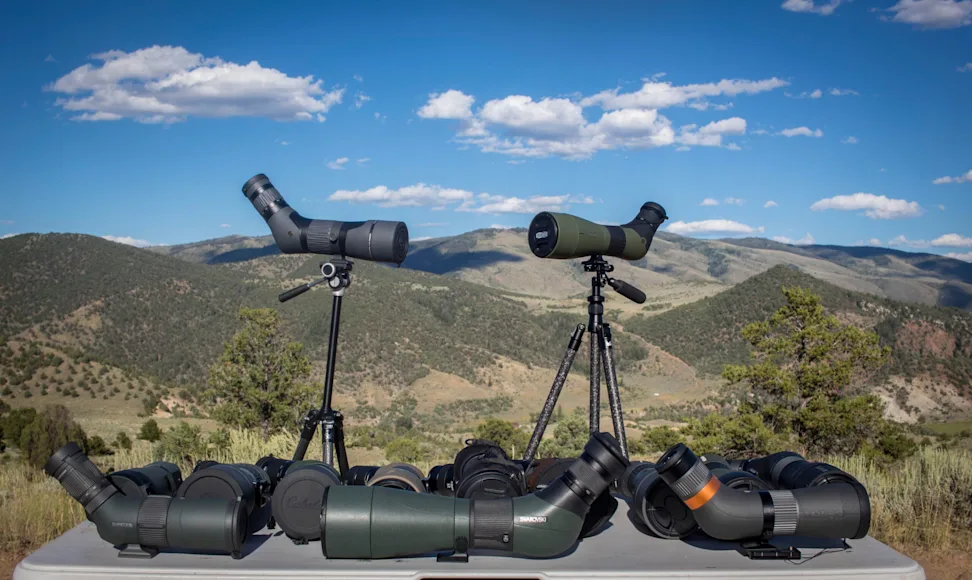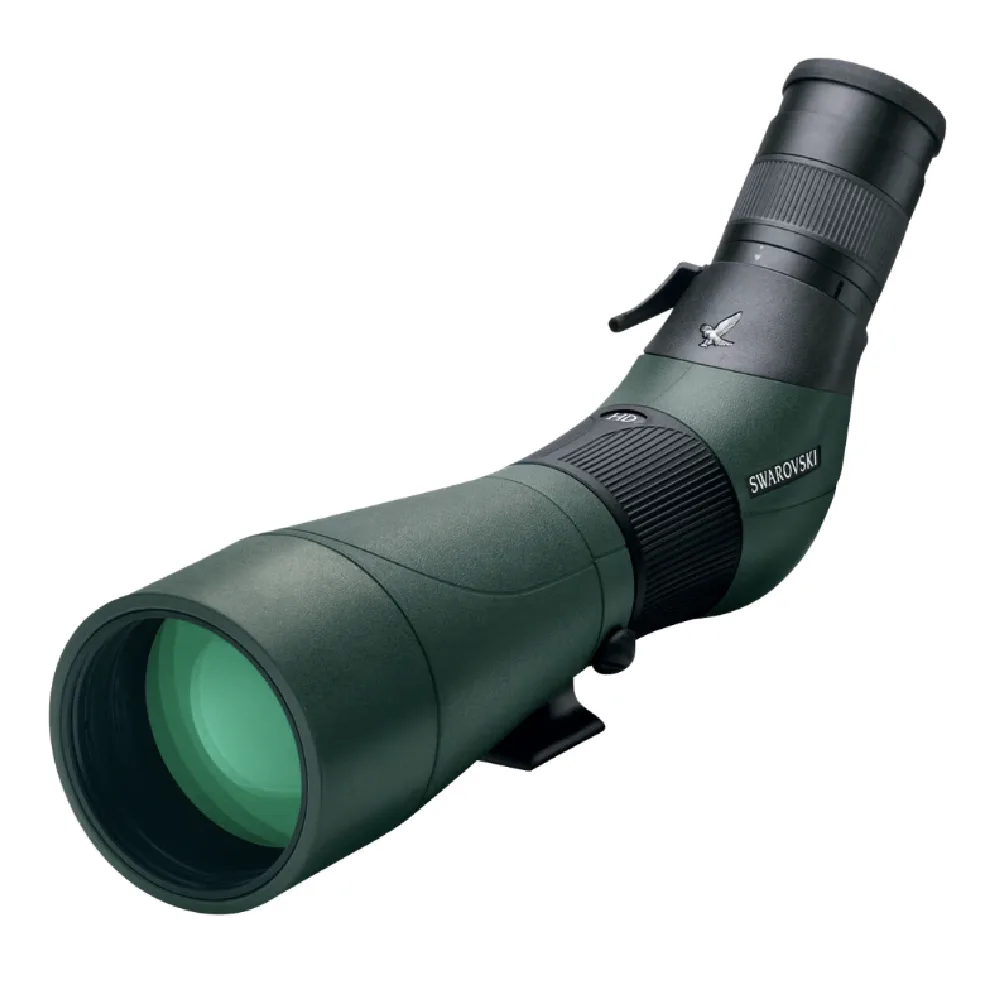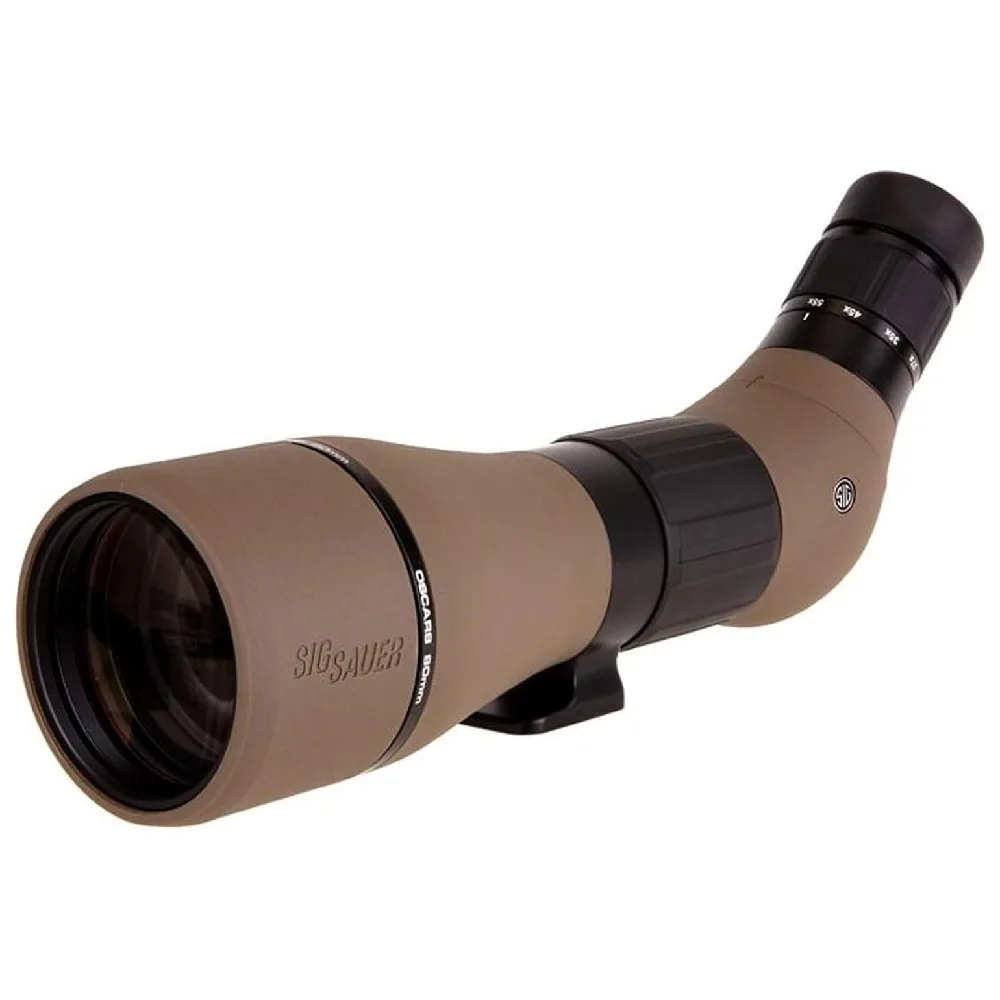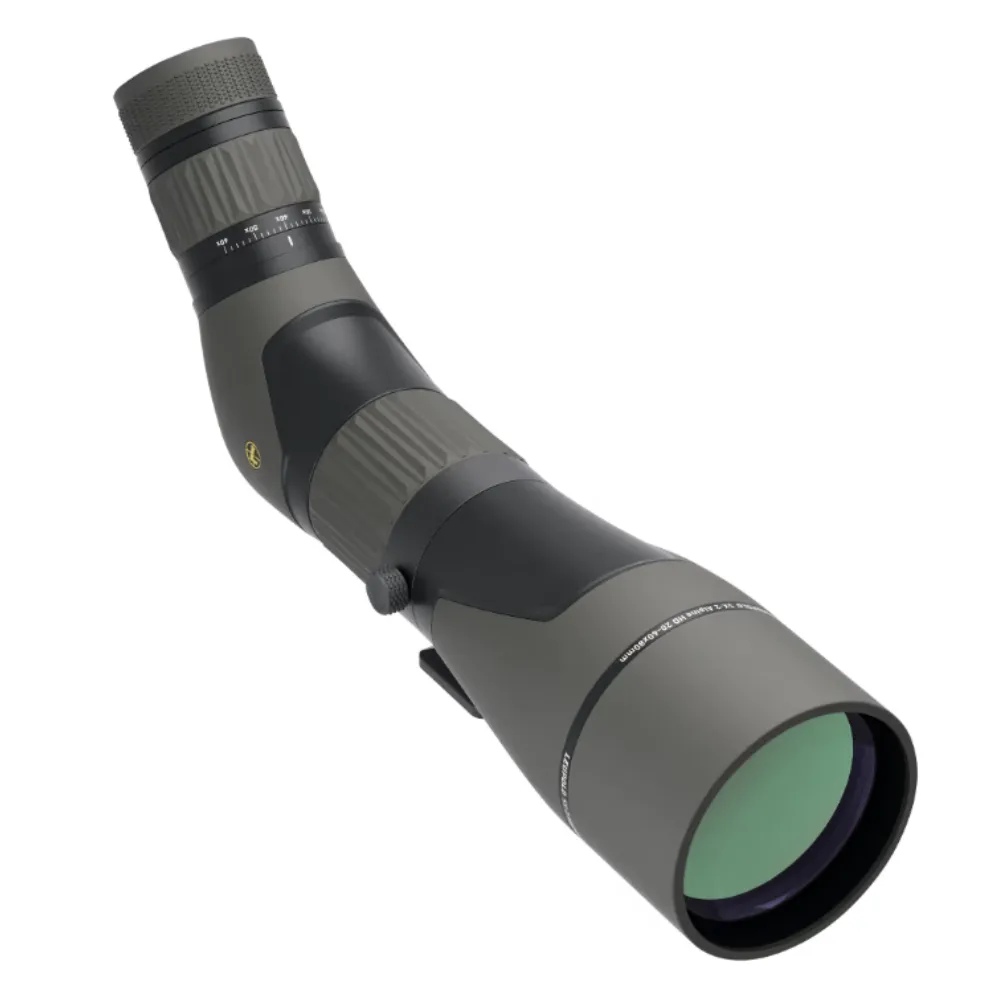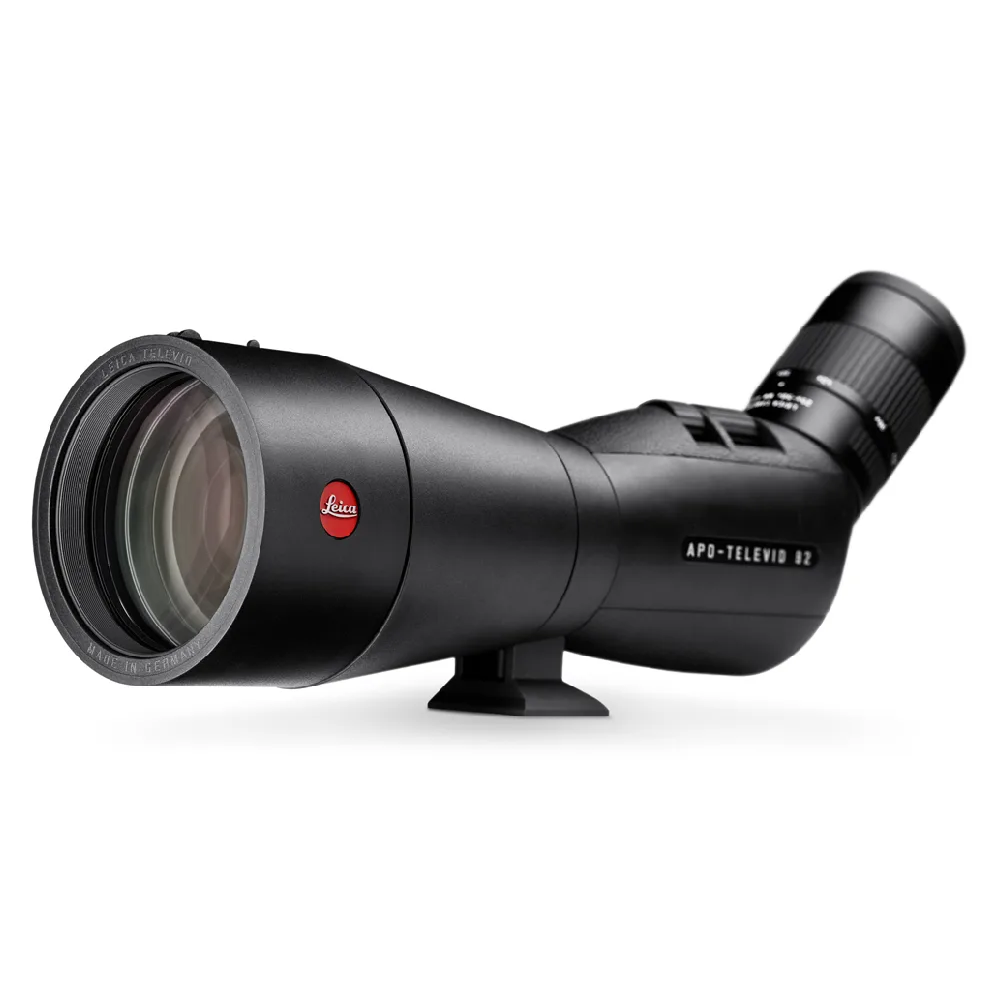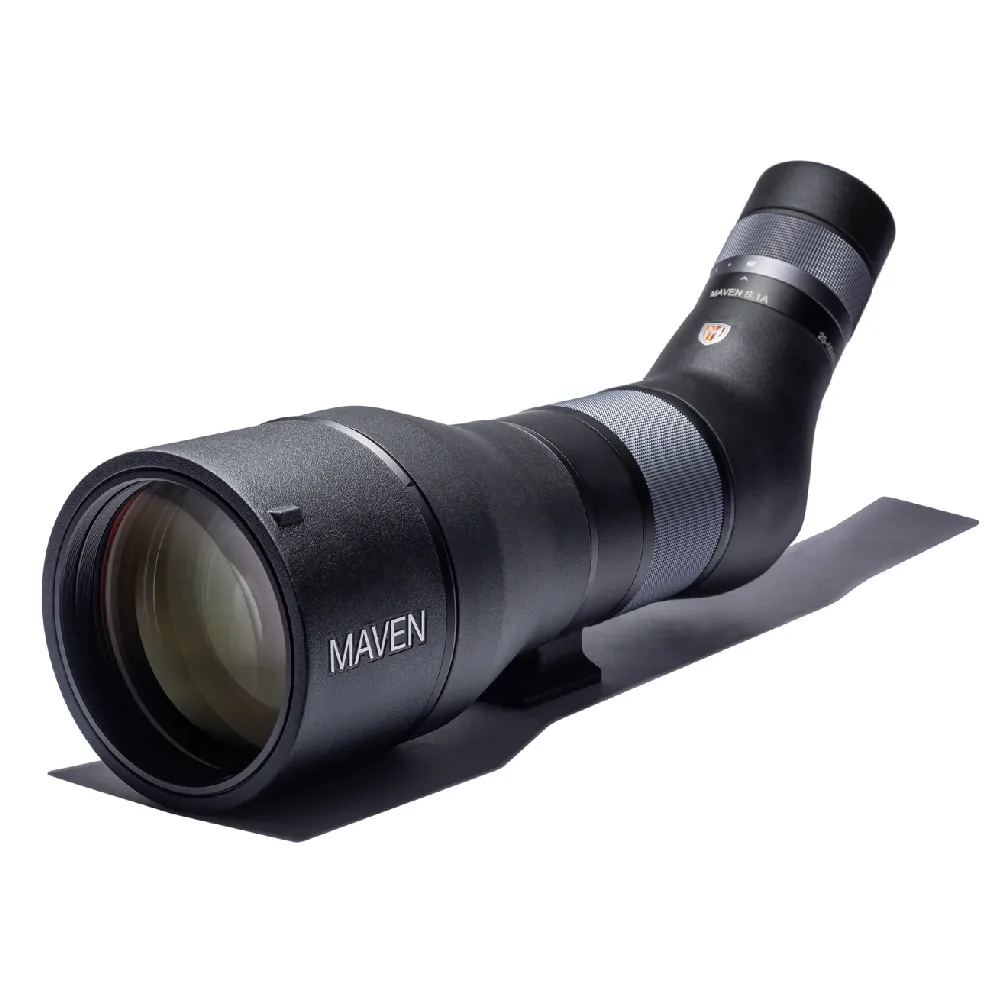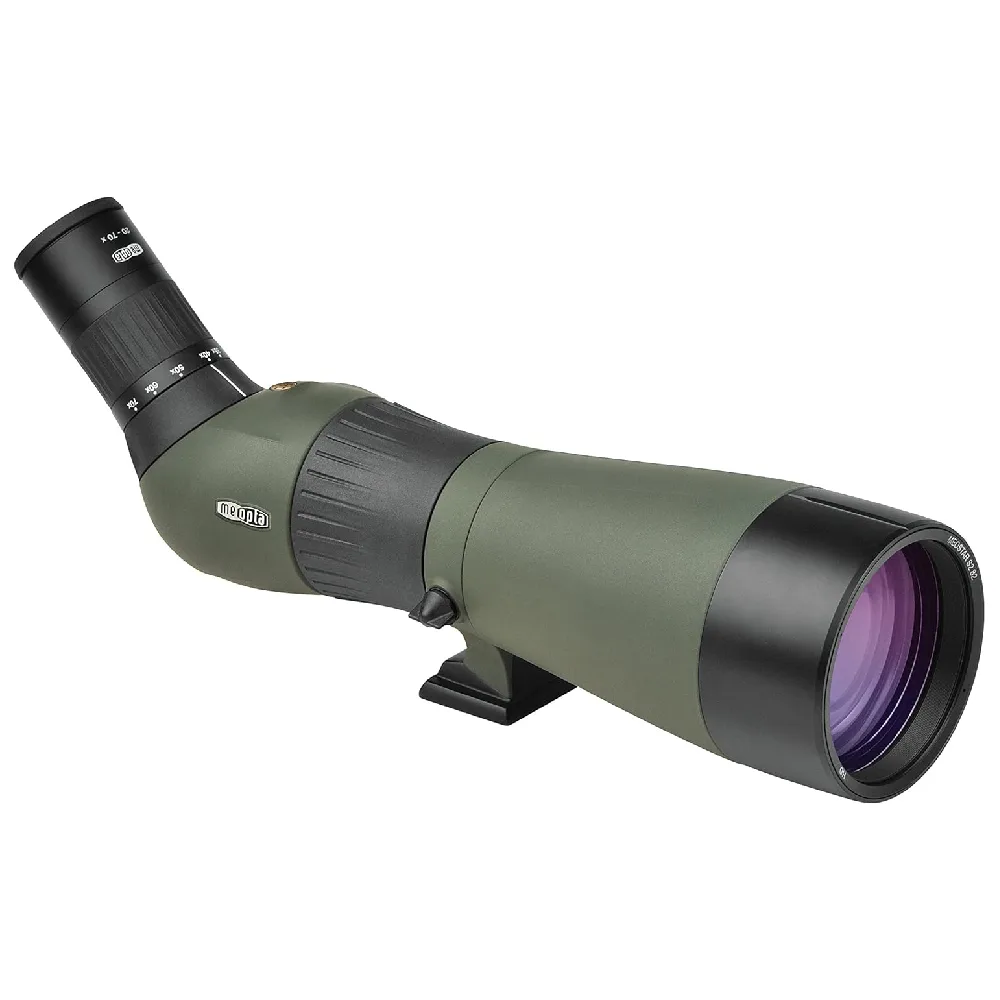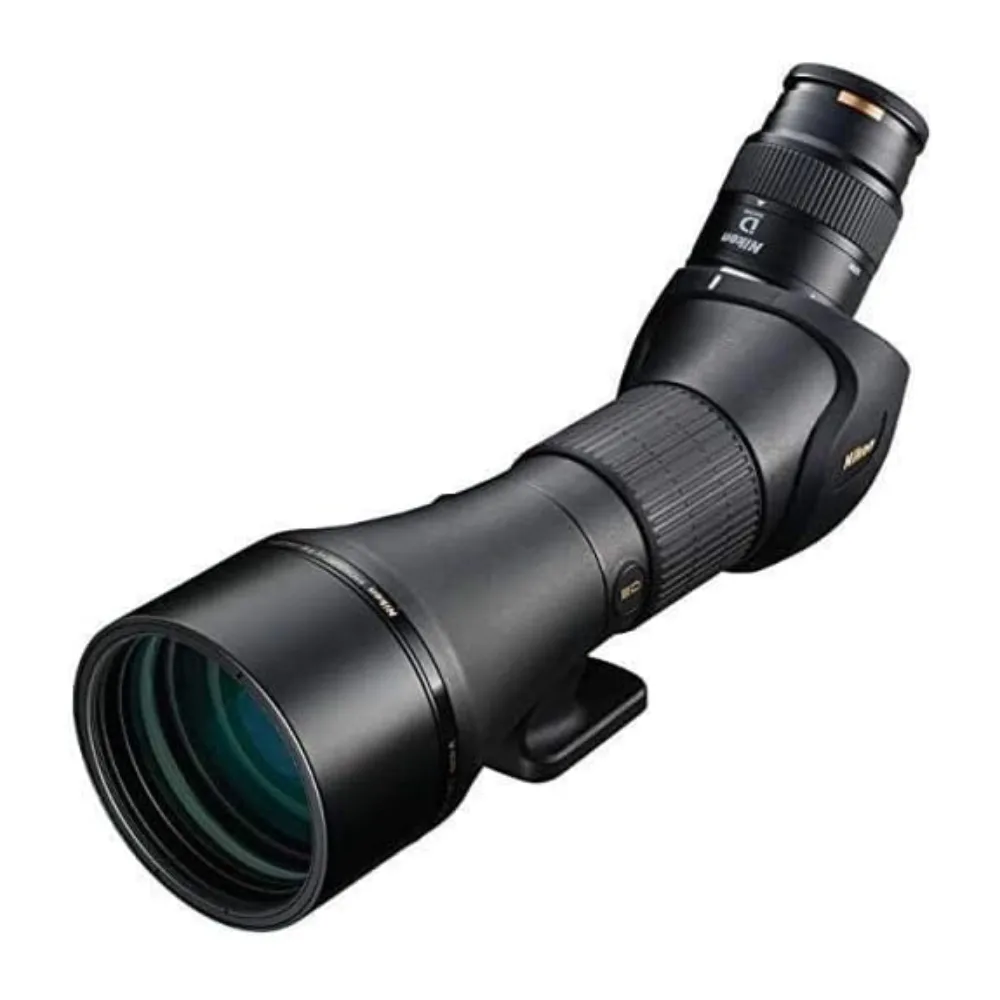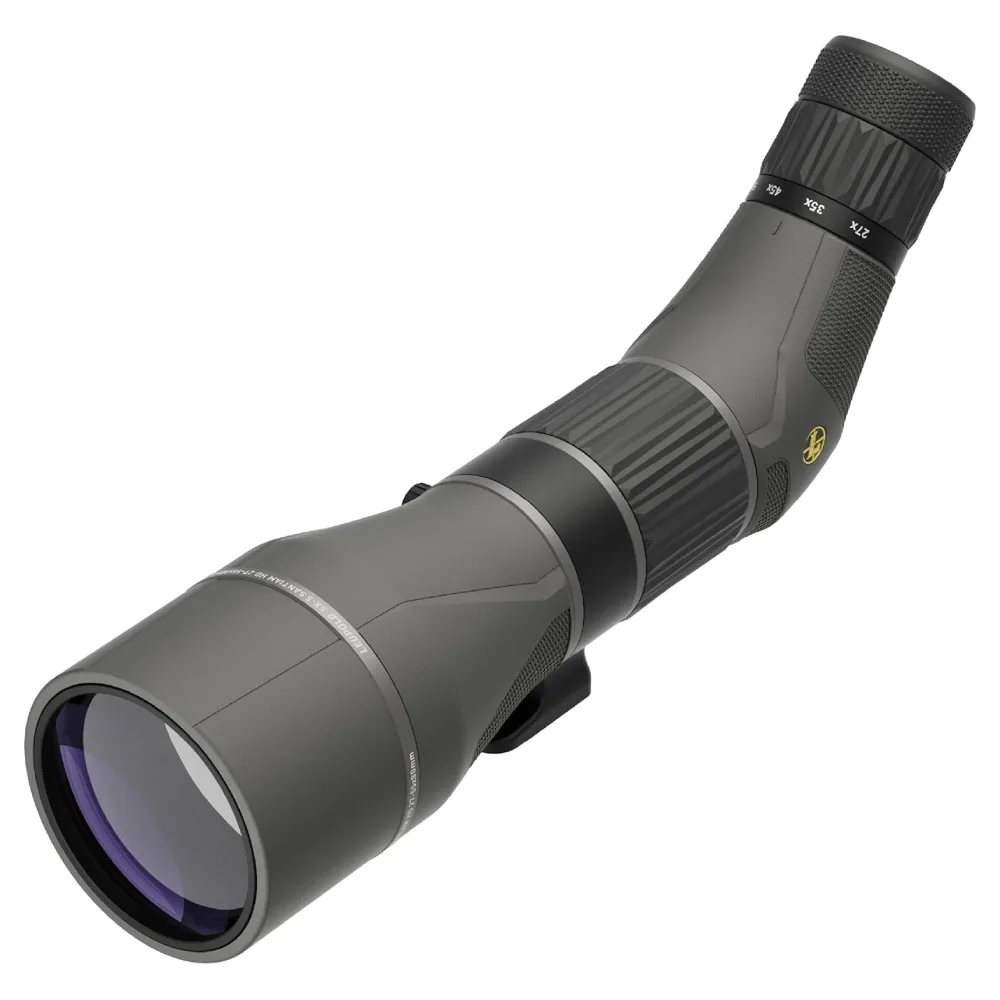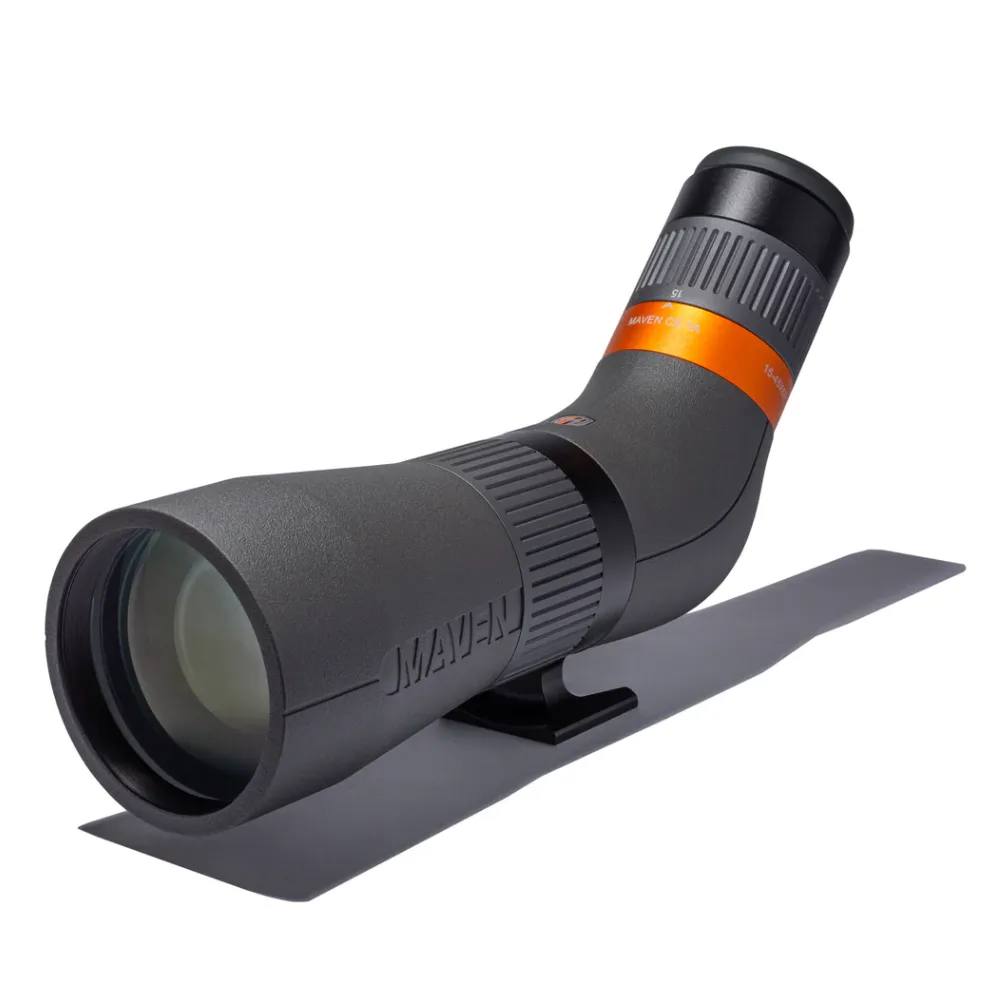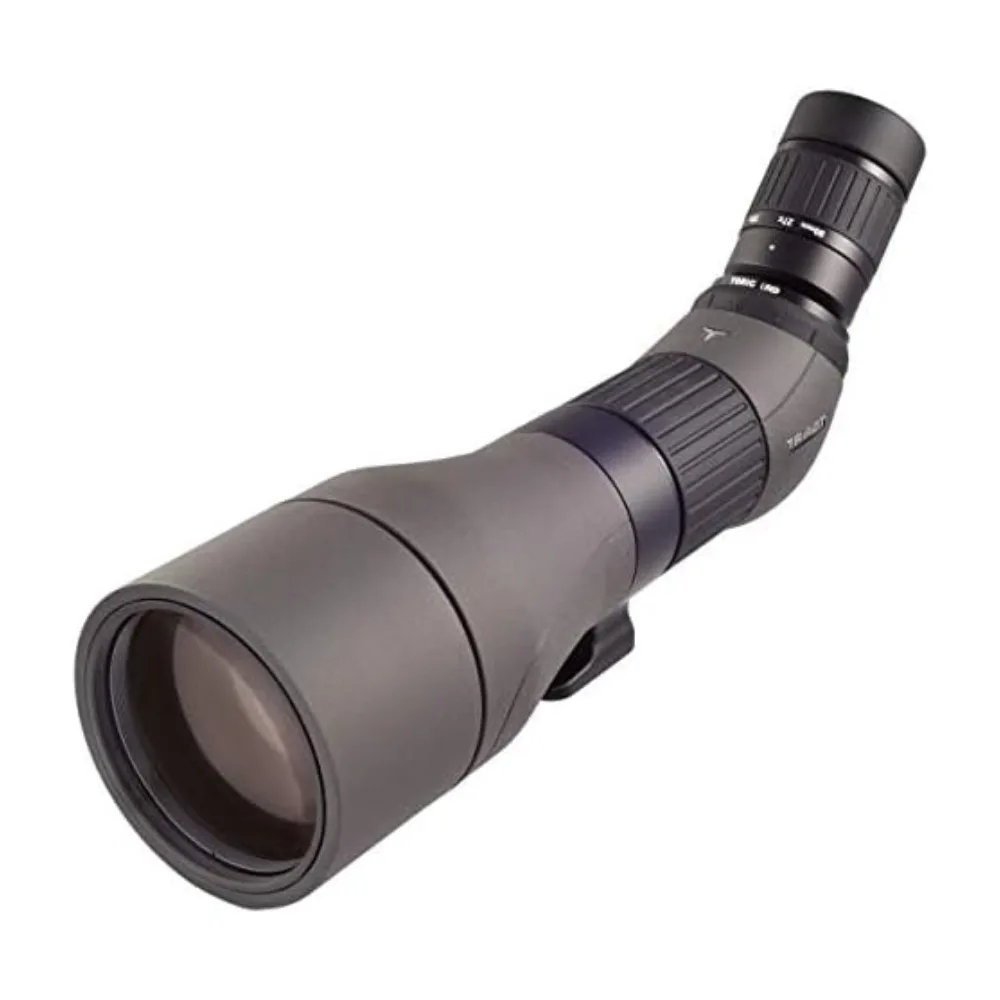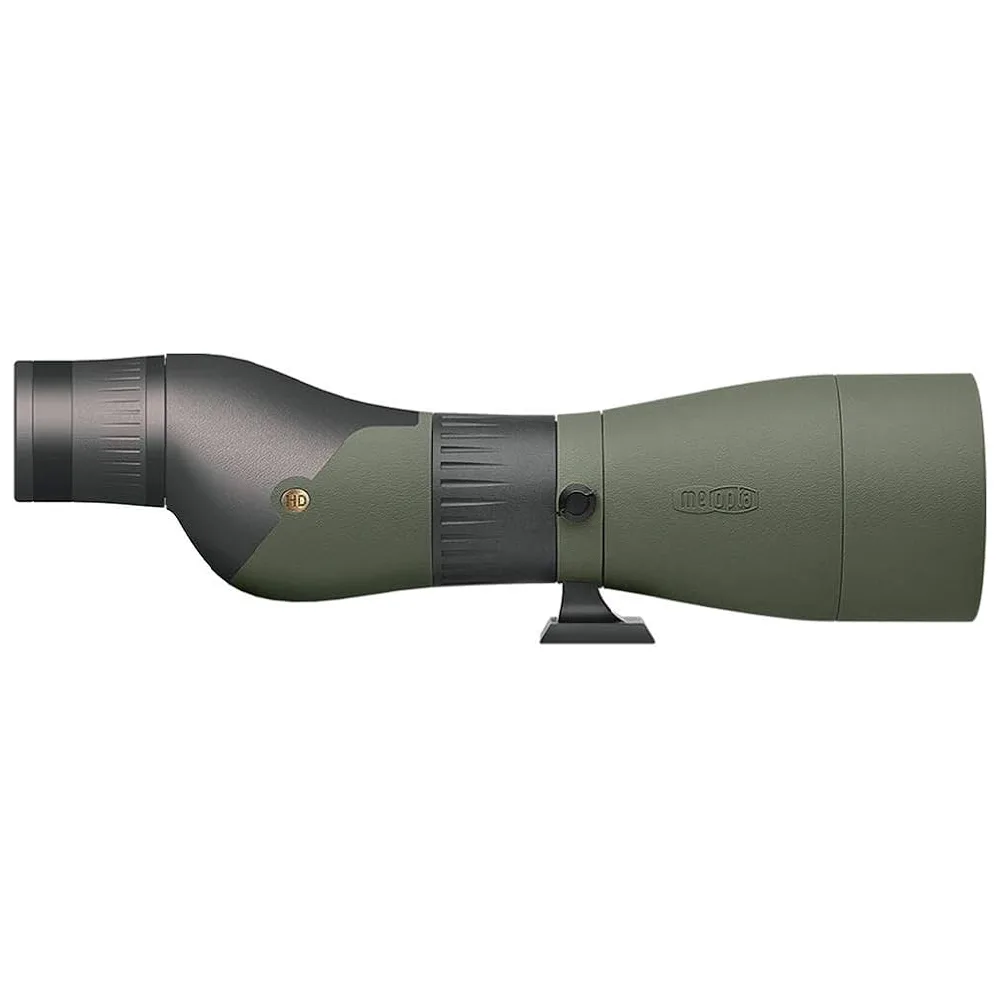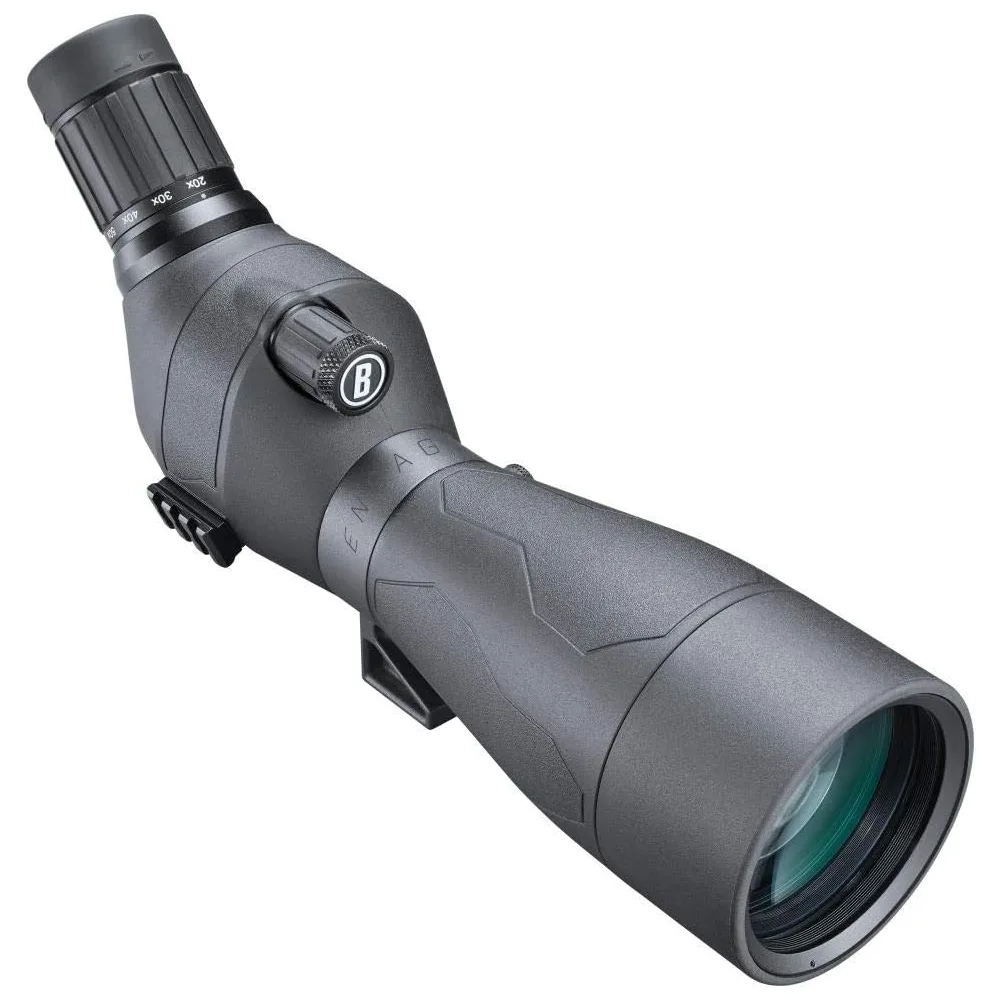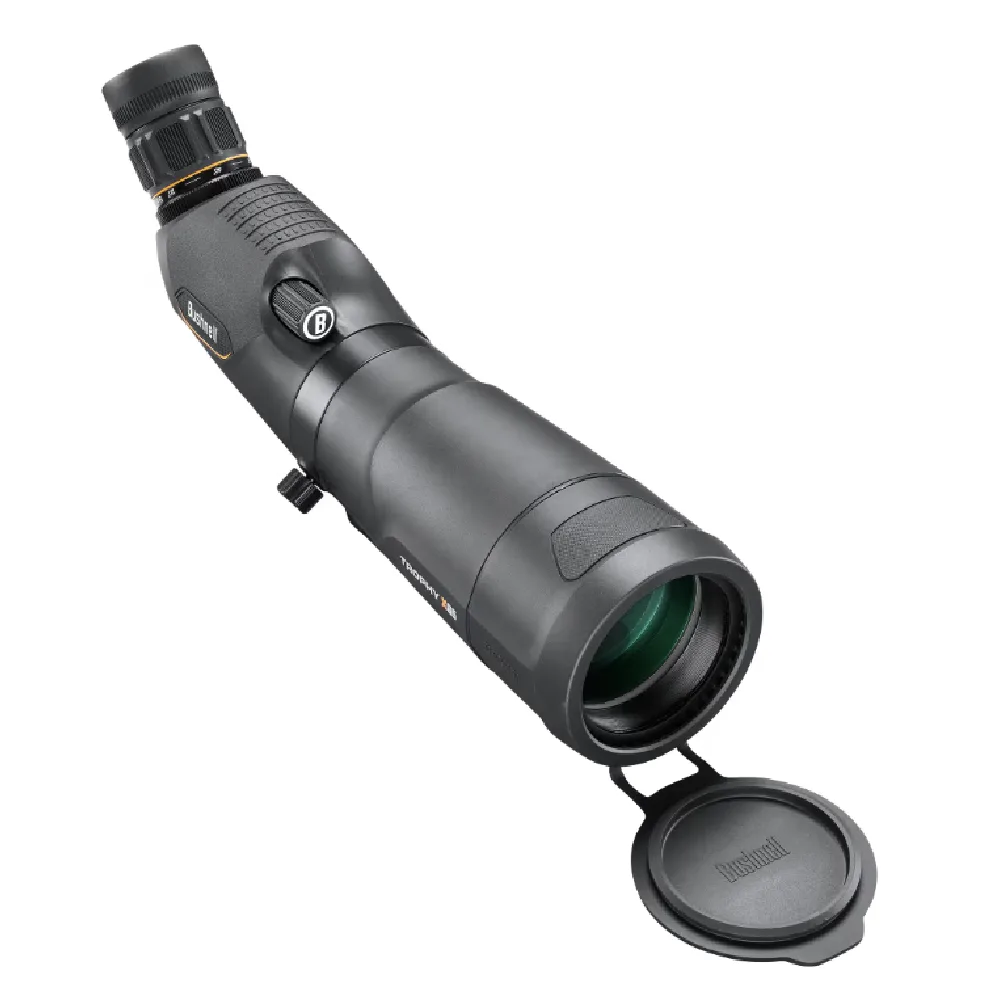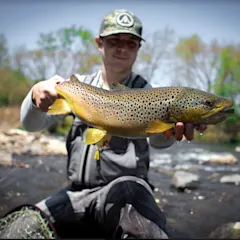We may earn revenue from the products available on this page and participate in affiliate programs. Learn more ›
Unlike compound bows, spotting scope manufacturers don’t release a new flagship model each year. In fact, many optic companies will go years between developing a new spotter. That’s why, as hunters, we aren’t looking for the newest spotting scope available. Instead, we’re looking for the best spotting scope available.
This past summer, we reached out to major optic manufacturers and asked them to send us their best spotting scope on the market—new or old. What we got was a lineup of 15 spotters in a wide range of magnification, objective lenses, sizes, and purposes. Our plan? To put them through a comprehensive test to find the top performers for hunters. We took the scopes into the mountains and put them through the wringer to determine not only the best glass, but the best spotting scopes for specific situations and budgets. Here are the results.
Best Overall: Swarovski ATS 80 20-60×80
Best Value: Sig Sauer Oscar 8 27-55×80
Best Compact: Vortex Razor HD 13-39×56
Best Budget: Leupold SX-2 Alpine HD 20-60×60
Rest of the Best
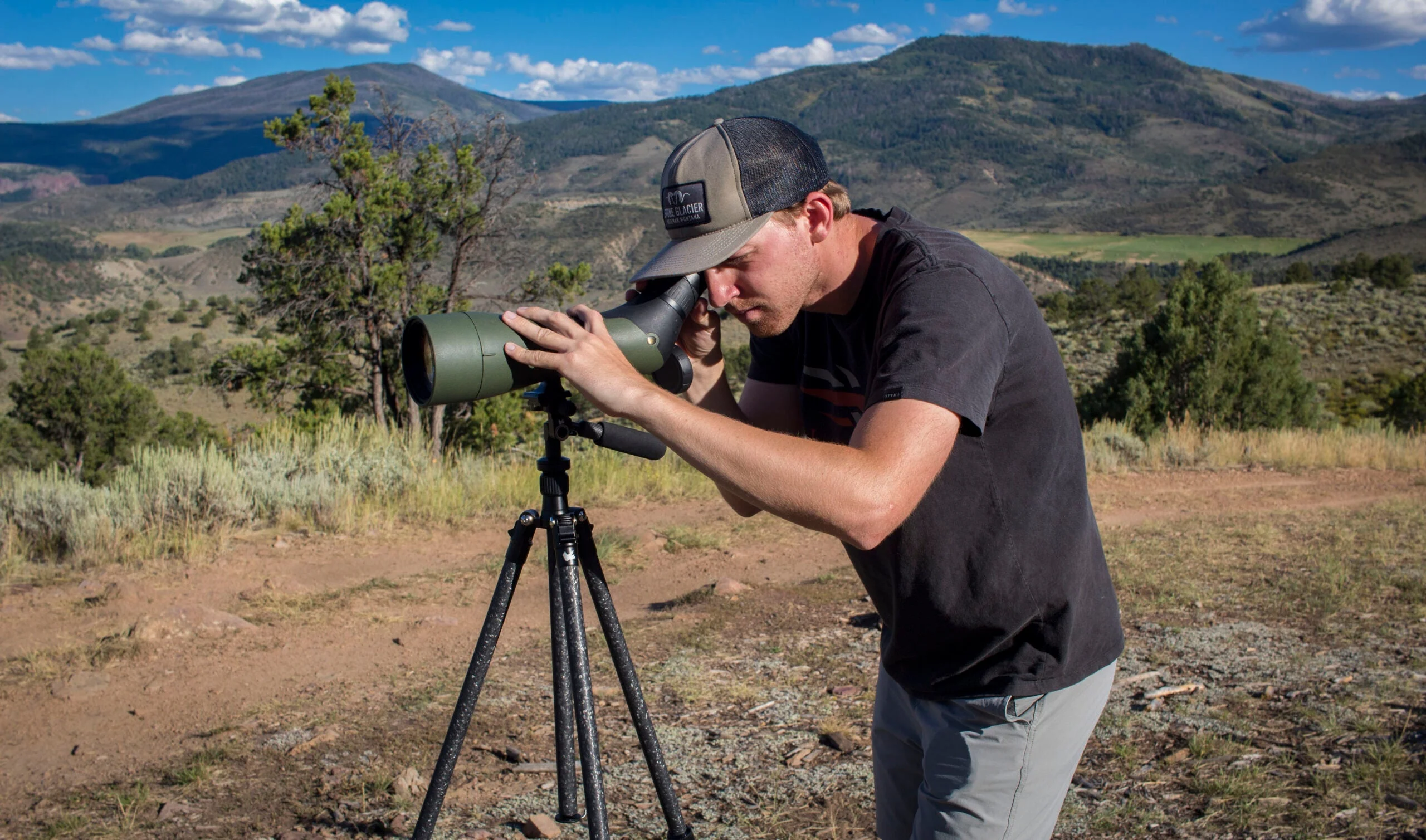
Best Overall: Swarovski ATS 80 20-60×80
Specs
Magnification: 20-60X
Objective Lens Diameter: 80mm
Weight: 57.8 ounces
Length: 15.8 inches
Eyepiece: Angled
Total Score: 95.5
Pros
Best in optical resolution, image quality, and low-light performance
Smooth focus wheel
Fully waterproof/fogproof
Excellent build quality/durability without being too heavy
Cons
Very expensive
It isn’t every gear test that we have one product outperform the others as the Swarovski ATS 80 did. This spotter was hands down the best in optical resolution, image quality, and low-light performance. It was also the only scope where I could clearly see the entire -1 grouping on the USAF test chart (on an 8×11 piece of paper) at 100 yards. What’s even more impressive is that the image was almost as detailed and clear in the shade. We recorded no chromatic aberration or color shifting, as well as no stray light or blurring around the edges. It is as close to perfect as you can get.
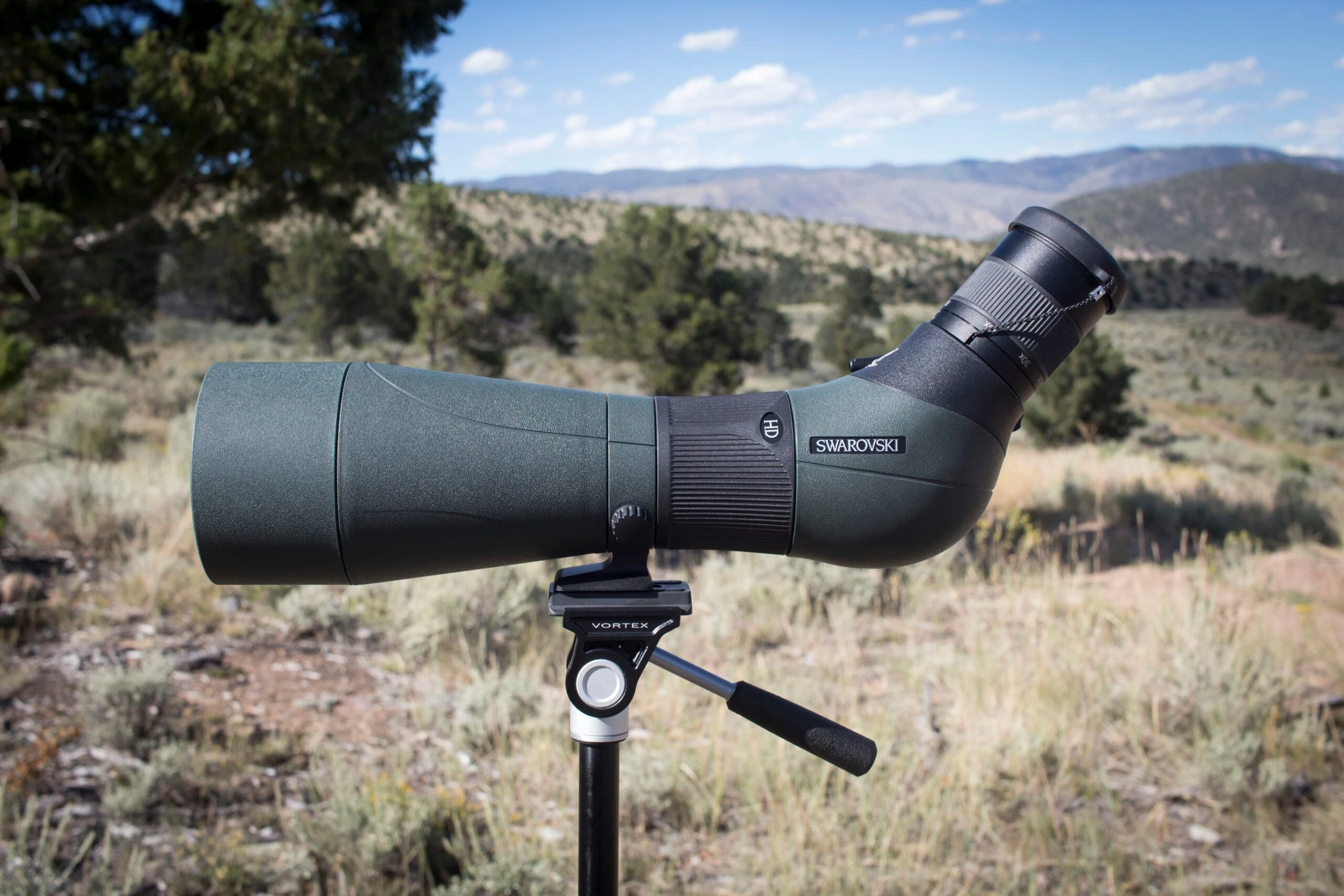
We experienced zero fogging or any other negative effects after submerging the ATS 80 in water and then freezing it. It will handle anything you throw at it in the field. Naturally, I chose it as my spotter for a week-long backcountry archery elk hunt and late-season mule deer hunt. I had no issues carrying it around the mountains for seven days straight. This full-size spotter weighs 57.8 ounces, the sixth lightest scope in the test. You can purchase it with an angled or straight eyepiece.
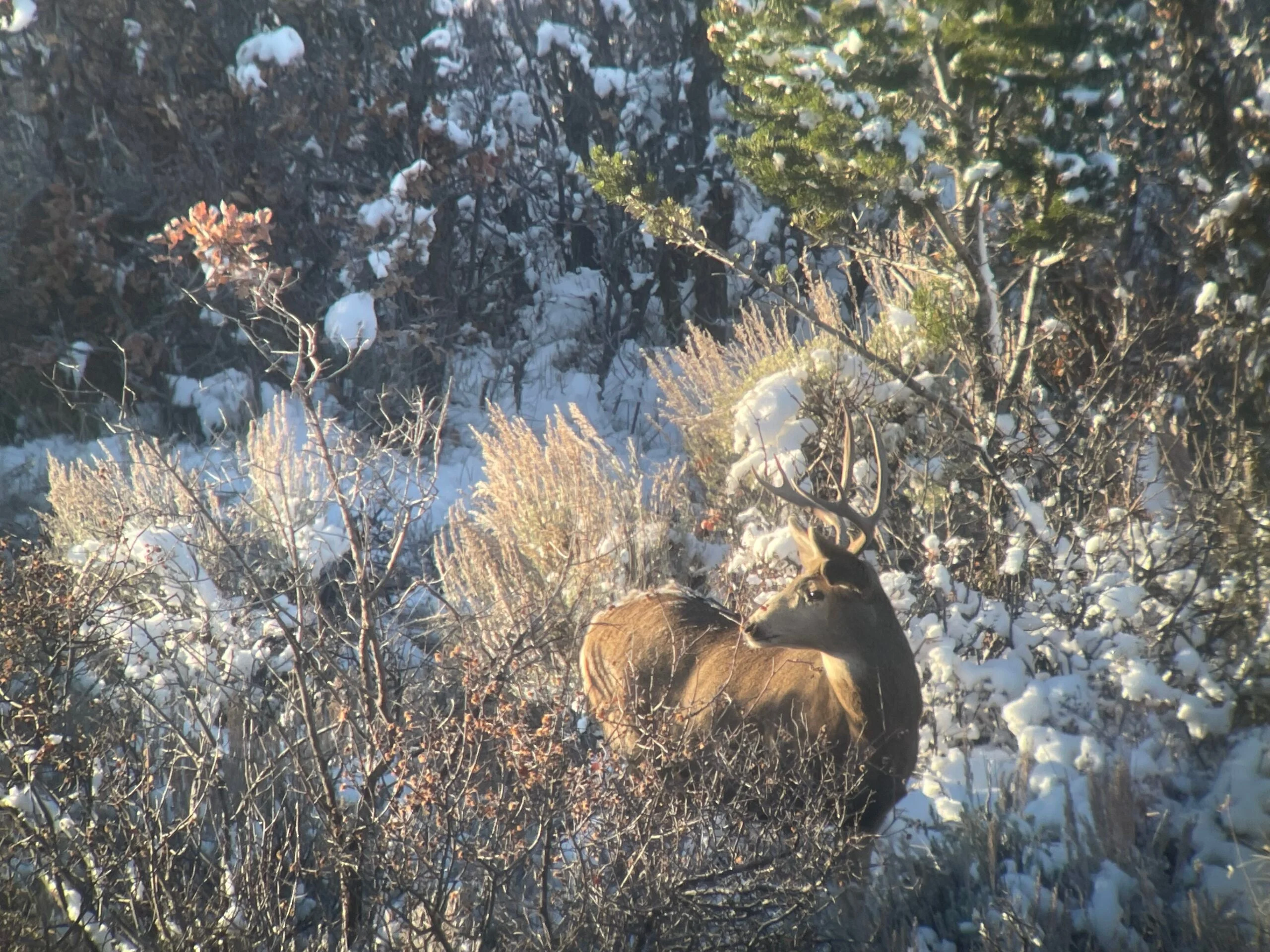
Besides its incredible optical performance, the ATS 80 shines in the small details. It comes with a durable and secure lens cap, and the focus wheel is silky smooth. I don’t recommend dropping a $3000-plus spotting scope in the field, but the ATS 80 is more than capable of taking a few bruises. Speaking of price, this spotter is extremely expensive. But you’re paying for the best of the best. And the Swarovski ATS 80 is the top-performing spotting scope on the market. —Ryan Chelius
Best Value: Sig Sauer Oscar 8 27-55×80
Specs
Magnification: 27-55X
Objective Lens Diameter: 80mm
Weight: 67.2 ounces
Length: 15 inches
Eyepiece: Angled only
Total Score: 91
Pros
Smooth focus and magnification wheels
Large field of view
Works great with MagView and other phone scope mounts
Fully waterproof/fog-proof
Reasonably priced
Cons
Poor-quality neoprene cover
When referring to the Best Value award, we are looking for a scope that punches way out of its league for its price point (not necessarily a budget option). That means excellent performance, build quality, and a price point that’s justifiable. Of all the scopes we tested, none proved their value like the Sig Sauer Oscar 8. Good optical resolution, image quality, and excellent low-light performance put this scope on par with the premium spotters in the test.

The 80mm objective lens lands on the wider end and yields a great feeling of immersion. It was simple to get on target, smooth to focus, and presented us with crisp images. The resolution test yielded consistent clarity in the -3 and -2 USAF Test Chart groups at 100 yards. Low-light testing yielded the same results, something few other scopes were able to do.

The Oscar 8 had no issues passing the waterproof/fogproof test—earning a perfect score. We were also thoroughly impressed with the build quality. Crisp but smooth magnification and focus wheels were easy to adjust, and each tilt adjustment was met with a firm click. Subtle things like lanyards on the lens caps made the attention to detail evident in its design. By no means is this a cheap scope. That said, the performance-to-price ratio made it the clear winner for Best Value. —Max Inchausti
Best Compact: Vortex Razor HD 13-39×56
Specs
Magnification: 13-39X
Objective Lens Diameter: 56mm
Weight: 28.6 ounces
Length: 10 inches
Eyepiece: Angles or Straight
Total Score: 84
Pros
Extremely lightweight
Excellent low-light performance
Smooth focus and magnification wheel
Easy to pack
Great feeling of immersion
Cons
Some water got through threads after being submerged in water
If you’re looking to bring a spotting scope into the field and want to remain as light as possible, the Vortex Razor HD is your answer. This brand-new 12-39×56 spotter is the latest offering in the compact spotting scope category. It was by far the lightest scope we tested, weighing only 26.8 ounces. And for a scope with a max magnification of 39x, I was surprised with how good the detail was. The Razor HD also proved to have an excellent feeling of immersion and good image quality.
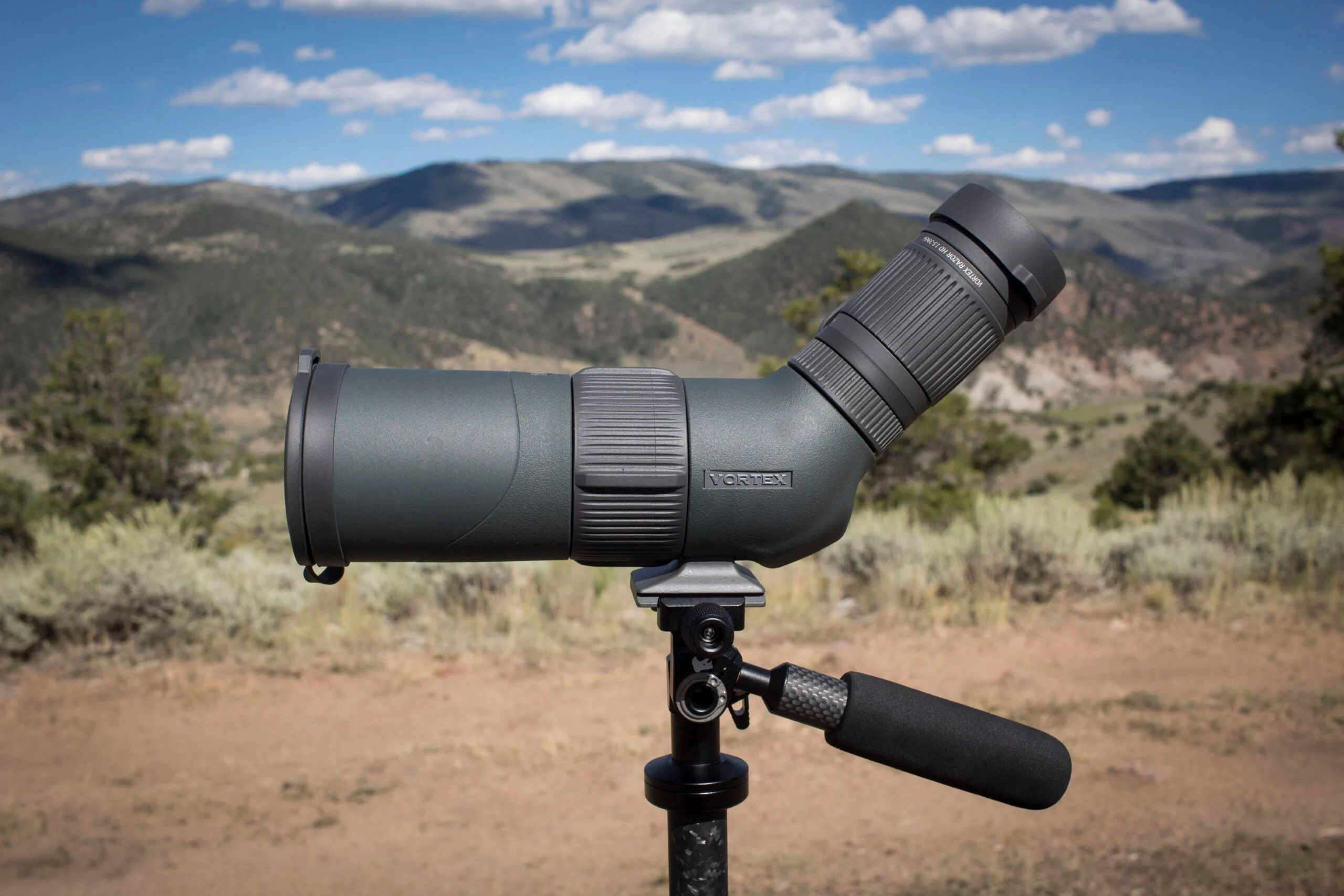
We noticed some color shift and minimal blurring around the edges. This slightly affected image quality, but nothing too dramatic. After submerging the Razor HD in water and freezing it, there was some fogging on the inside of the eyepiece. We unscrewed the eyepiece and wiped away the fog, and the scope was as good as new. This wasn’t ideal, but we didn’t experience any fogging on the outside of the lenses. So as long as you don’t submerge your Razor HD underwater, it should be fine in most conditions.
The build quality and ergonomics of this spotting scope were right there with the best. It feels great in the hand and all of the adjustment knobs are smooth. Again, the biggest appeal of this spotter is the impressive, lightweight build. In fact, it is 12 ounces lighter than the next best compact scope we tested. Hunters that are set on minimizing pack weight should seriously consider the Razor HD. It is a bit pricey for a spotter that only reaches 39x magnification, but you’re paying for one of the lightest spotting scopes on the market. And when it comes to compact scopes, being light is crucial. —RC
Best Budget: Leupold SX-2 Alpine HD 20-60×60
Specs
Magnification: 20-60x
Objective Lens Diameter: 60mm
Weight: 60 ounces
Length: 14.3 inches
Eyepiece: Angles only
Total Score: 85
Pros
Very affordable with quality glass
Well-balanced
Durable—fully waterproof/fogproof
Cons
Not as clear as premium spotters
Some noticeable color shift
Any spotting scope under $500 was entered into the Best Budget category. This made for a pretty limited group, but we know that many hunters don’t want to spend a couple of grand on a new spotting scope. So we wanted to find the best lowest-priced spotter out there. Enter the Leupold SX-2 Alpine HD.

I am still trying to figure out how Leupold sells the SX-2 Alpine HD for so cheap. We had no issues resolving detail on many of the smaller test chart groupings, even clearly making out one grouping that only premium scopes were able to resolve detail in. Which proved this spotter was punching out of its league.
As for image quality, there was some noticeable color shift (a blue/purple streak) when looking at the 1-inch black cross. It also had a poor feeling of immersion or the lack of feeling like you were in the image. But those are small prices to pay for a spotting scope with such high-quality optical resolution at a ridiculously low price. The SX-2 passed the weather resistance test without blinking an eye, meaning this spotter can handle the harshest conditions in the field.
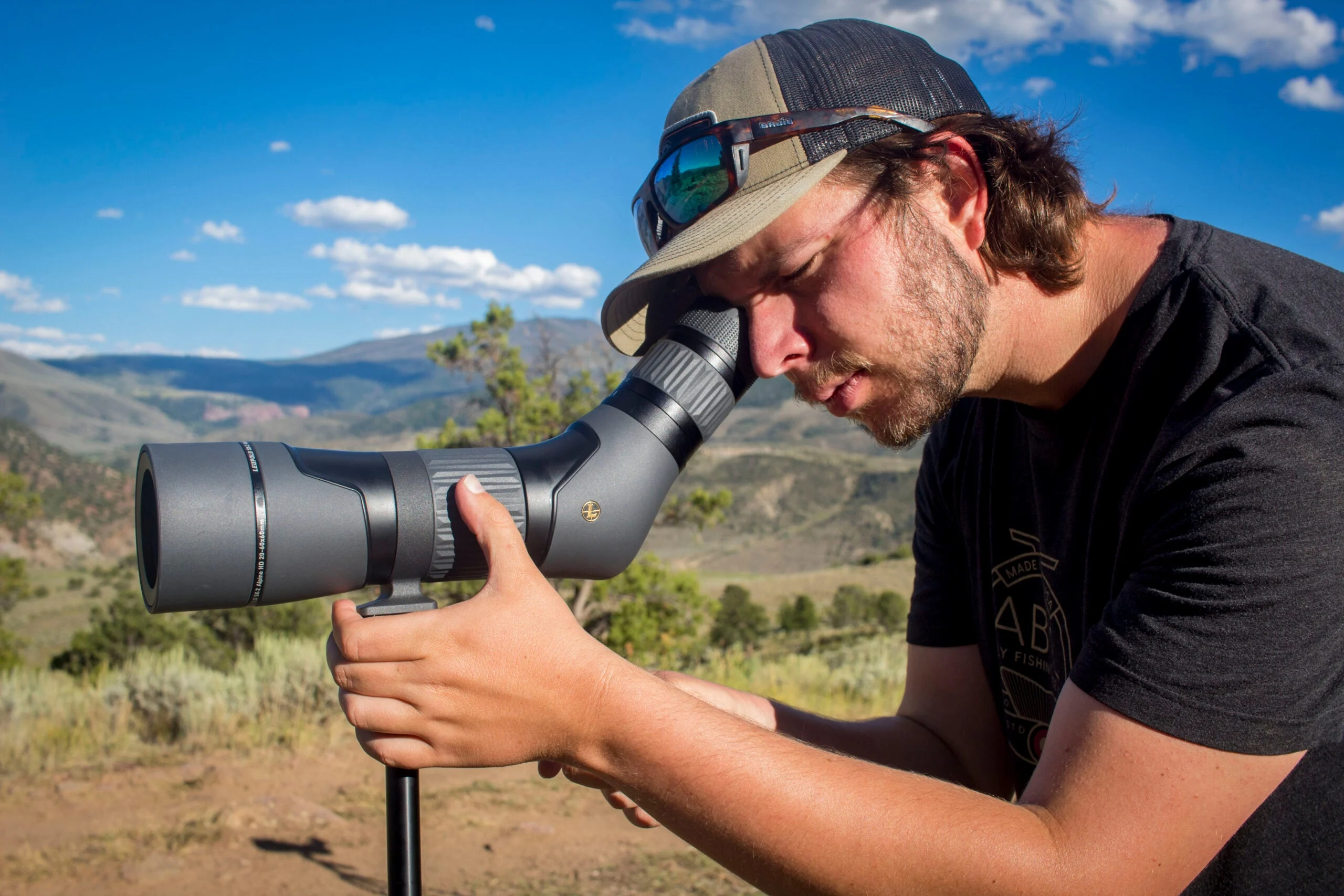
The SX-2 only got better as we examined its build and ergonomics. It isn’t overly heavy, and the focus and magnification wheels are easy to adjust and control. While it falls a little short in clarity and low-light performance, the value of this scope is unmatched. You won’t be able to see as many fine details, but this scope is also $3000 cheaper than the premium spotters. And it will perform just fine for most hunters or those just getting started in western big game hunting. —RC
The Rest of the Best Spotting Scopes of 2023
Leica APO Televid 25-50×82
Specs
Magnification: 20-50x
Objective Lens Diameter: 82mm
Weight: 47.7 ounces w/o eyepiece
Length: 12.9 oz
Eyepiece: Angled or straight
Total Score: 94
Pros
Fine focus adjustment knob
Superior quality glass
Quality lens caps
Cons
Very expensive
The Lecia APO Televid excelled in every category and was the runner-up for Best Overall. A combination of achromatic lenses and fluorite glass delivered crisp images. We saw no color shifting, blurring, or stray light (even when facing the sun). The same held true in low-light testing, with nearly identical performance in optical resolution and image quality.

This same attention to detail translated to the APO Televid’s design. It featured coarse and fine focus adjustment knobs placed directly on top of the scope, rather than a focus wheel wrapping around the entire body. This was the easiest design to operate the full range of the focus wheel when paired with a neoprene cover. Premium quality lens caps and a smooth sun hood completed the package. We also found it surprisingly lightweight and compact for a full-sized spotter.
Leica offers a few add-ons that are worth noting. A 1.8x extender pushes magnification to an impressive 90X when paired with the eyepiece. They also make their own digiscoping adapter specific to Leica TL cameras (not phones). While we didn’t test the adapter, it would be a great addition for wildlife photographers.
This scope was the most expensive we tested. At $3700, even the most seasoned backcountry hunter may find it hard to justify spending the equivalent of a used car on a spotting scope. For those not phased by the price, rest assured that the Lecia APO Televid delivers premium glass, exceptional build quality, and superb attention to detail. —MI
Maven S.1A 25-50×80
Specs
Magnification: 25-50x
Objective Lens Diameter: 80mm
Weight: 64.5 ounces
Length: 14.9 inches
Eyepiece: Angled or straight
Total Score: 91
Pros
Lifetime warranty
Smooth operation
Waterproof/fogproof
Cons
Slight blurring on lower magnifications
The S.1 is Maven’s full-size spotting scope made to handle any conditions with consistent and crisp images. It is built with fluorite glass to optimize edge clarity and low-light performance. After extensive testing, it’s safe to say it lives up to these claims. The S.1 performed extremely well in the optical resolution part of the test, recording one of the highest scores. The image quality was also superb. There was minimal blurring around the edges and no stray light or color shift. The same can be said for low-light performance. Both optical resolution and image quality were nearly identical to full light testing.
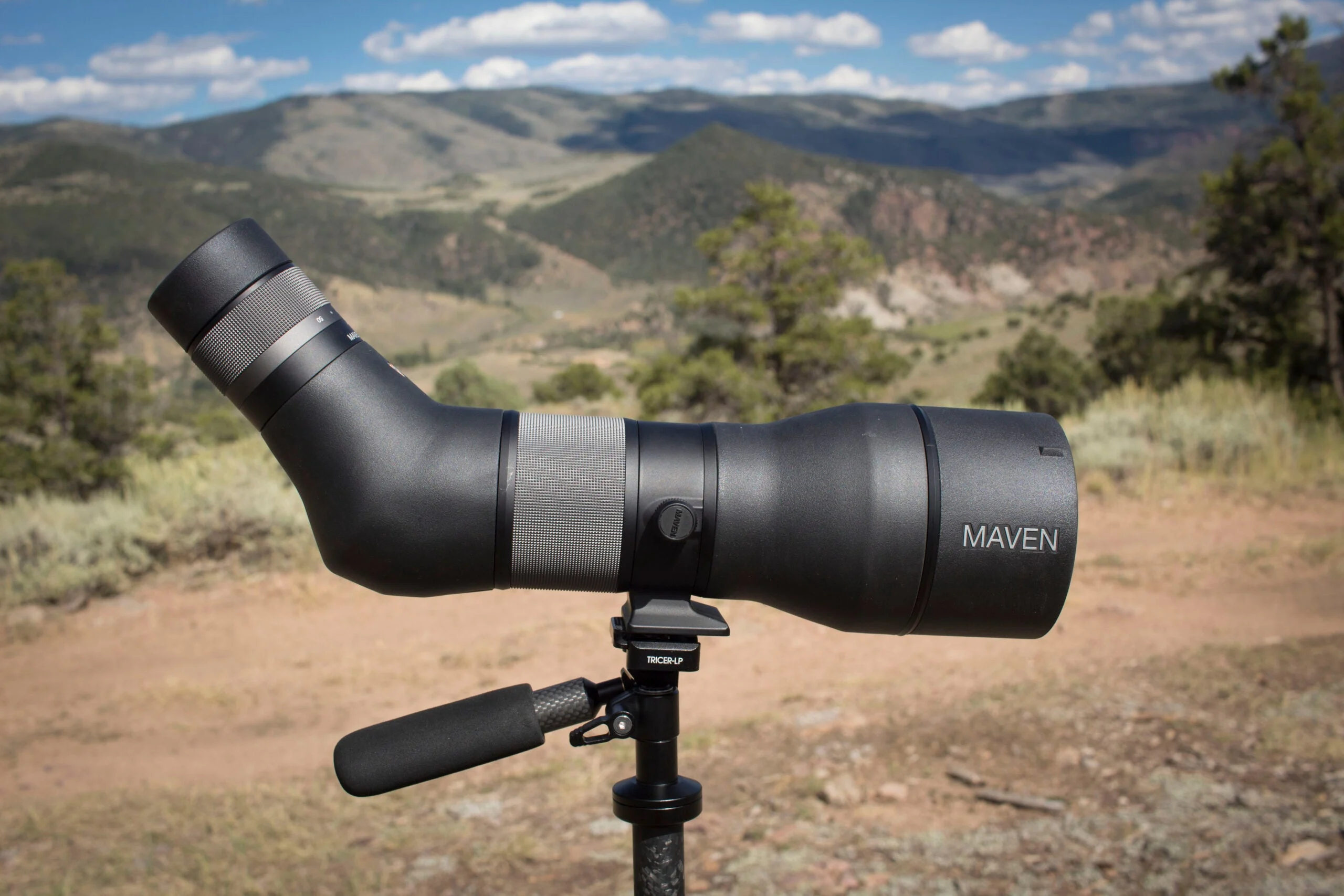
Fit and finish on this scope is also top-notch. The zoom and focus dials were some of the smoothest we tested. It’s paired with a quality eyepiece that is easy to operate with plenty of eye relief. This is also one of the nicest-looking spotters in the entire test. We opted for the gray and black color scheme, which looked slick in the field.

Priced at nearly $2000, this is one of the more expensive scopes we tested. That said, it offers premium glass and quality construction that match the price tag. If you need a little more convincing, every Maven scope comes with a lifetime warranty and is only available direct to consumer. This gives you a premium product at a slightly more affordable cost. Hunters can purchase the S.1 in with an angled or straight eyepiece. —MI
Meopta MeoStar S2 20-70×82
Specs
Magnification: 20-70x
Objective Lens Diameter: 82mm
Weight: 50.4 ounces w/o eyepiece
Length: 13.4 inches w/o eyepiece
Eyepiece: Angled or Straight
Total Score: 89
Pros
One of the highest-scoring spotters in optical resolution and image quality
Lightweight build
Great low-light performance
Wide objective lens and strong magnification
Cons
Expensive
The Meopta MeoStar had the widest objective lens and the strongest magnification (along with the Nikon) in the test. It was also one of the highest scoring in optical resolution and image quality. We recorded no color aberration, but some very slight blurring on the edges. Even with the subtle blurring, this was some of the best glass in the entire test.
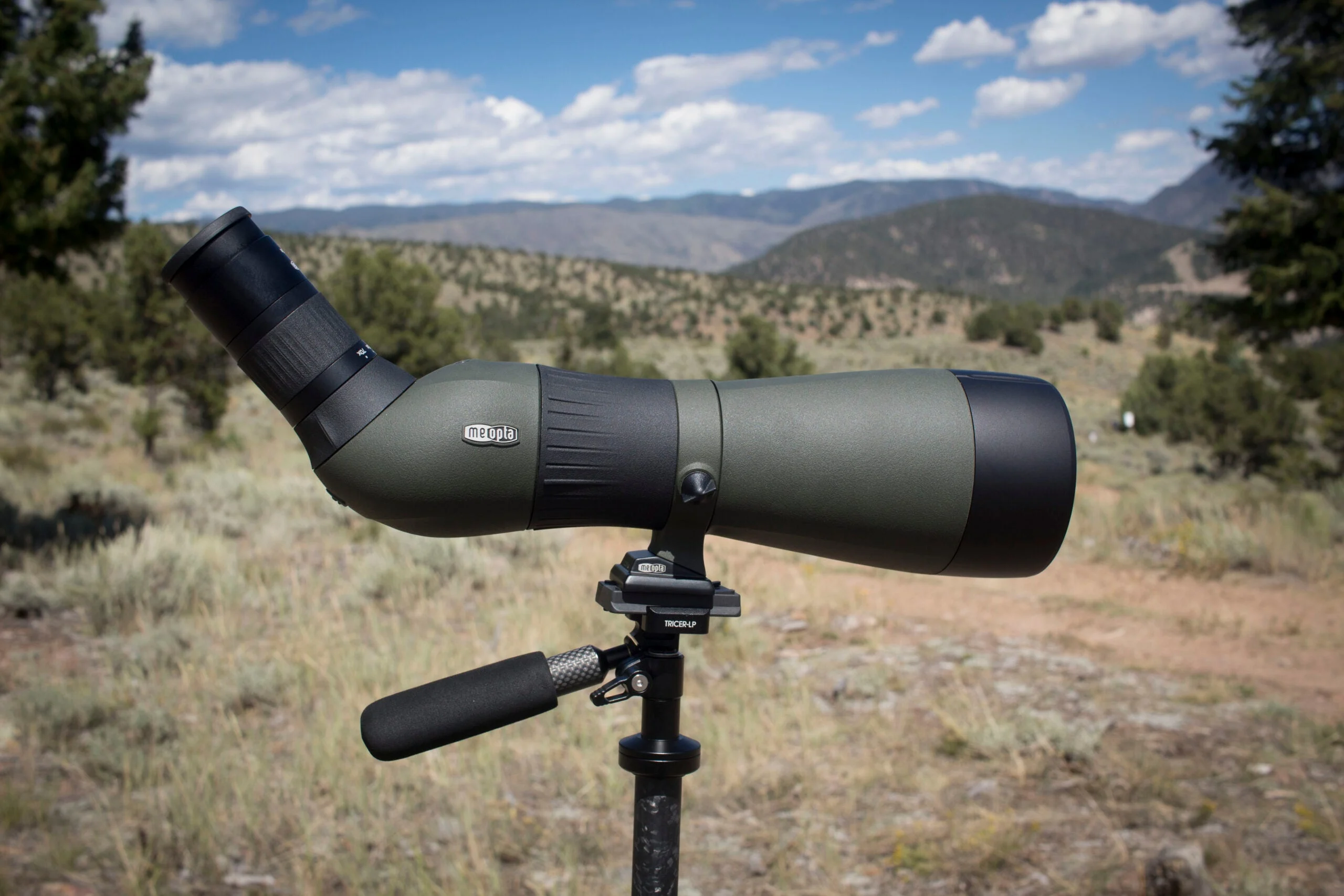
Its low-light performance was just as good, and our testers were able to see the same USAF chart groupings in dark shade as they did in full light. What kept this spotter below the 90-scoring mark was the weather resistance portion of the test. We recorded some fogging when we pulled the MeoStar from the ice, although it cleared up quickly.
Weighing only 50.4 ounces, this was one of the lightest full-size spotters we tested. And that lightweight design is a big deal for hunters, especially those venturing into the mountains for extended trips. The focus wheel is smooth and the build is strong. I found the magnification wheel to be a little stiff, but that should break in over time.
The steep price tag of the Meostar lands this in the premium category. And its optical resolution and image quality performance back that up. But for $3000, there should be absolutely zero fogging, even though it disappeared quickly.
This is a more affordable option than the Swaro and Leica, but the performance is also below those models. Still, when you combine the excellent optical resolution, image quality, and lightweight build, the MeoStar earns a spot in any serious hunter’s pack. —RC
Nikon Monarch 20-60×82
Specs
Magnification: 20-60x
Objective Lens Diameter: 82mm
Weight: 57.8 ounces
Length: 13.1 inches
Eyepiece: Angled or Straight
Total Score: 87
Pros
Solid resolution and image quality
Fully waterproof/fogproof
Lightweight for full-size spotter
Excellent ergonomics
Cons
Some blurring around the edges
Would like to see magnification listed on the wheel
You’re looking at the runner-up for the Best Value award, falling four points behind the Oscar 8. But make no mistake: The Nikon Monarch still offers some of the best value on the market. When it comes to optical resolution and image quality, the Monarch teeters on the line of a premium spotting scope at less than half the price. It provides a solid, clear image at 100 yards, only falling a little short of making out some of the smaller groups on the USFA Test Chart. We also recorded no color shifting, but some very slight blurring on the edges.

This spotter had an excellent feeling of immersion. One of the testers commented, “It feels like I am jumping into the image.” It also scored towards the top in low-light clarity. Hunters should have 100 percent confidence in this spotter’s durability—it didn’t fog at all after being submerged and frozen.
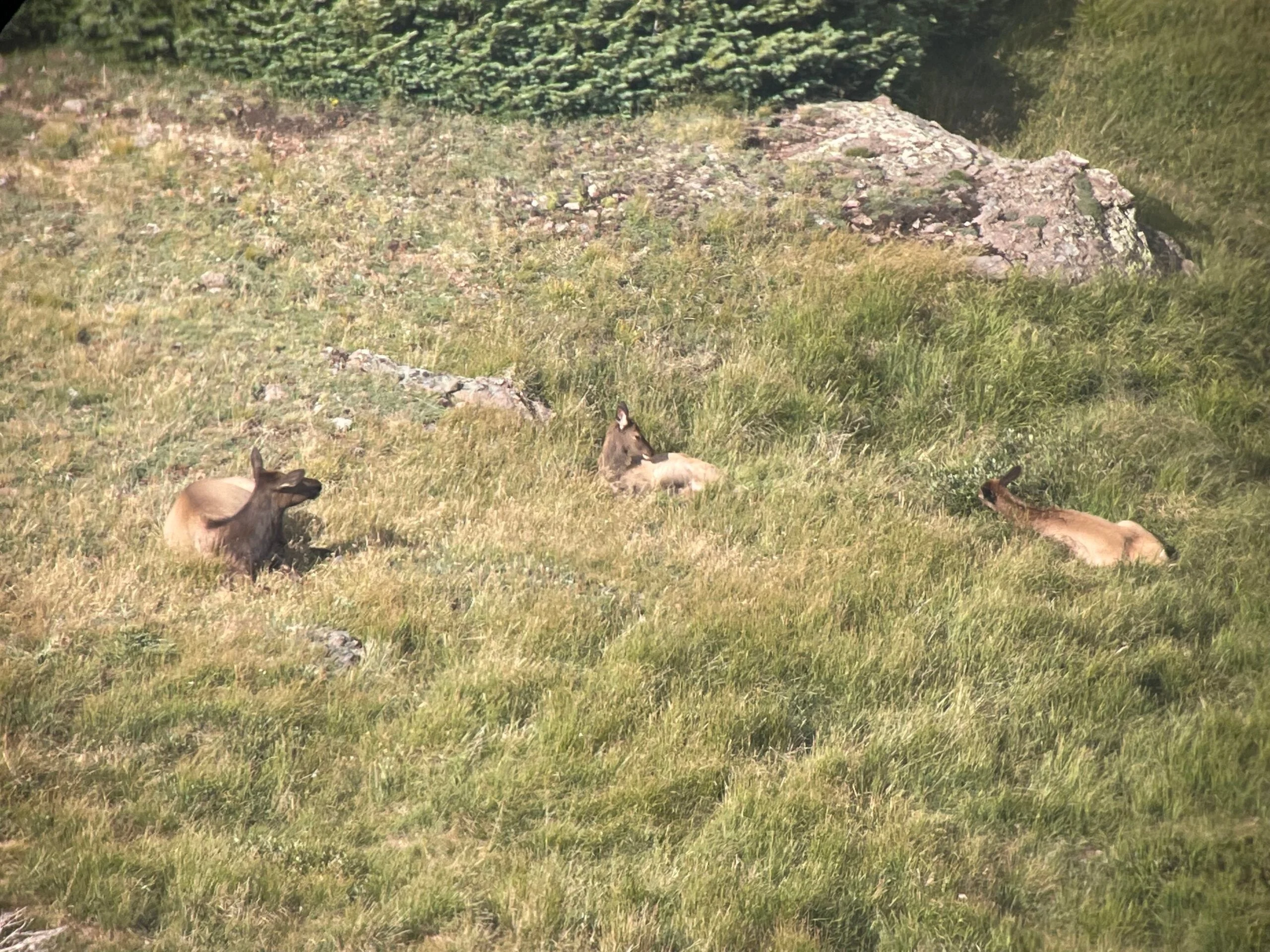
Besides the great glass, the Monarch is modest in weight for a full-size scope and will slide nicely into the side pocket of a pack. It also has an 82mm objective lens, tied for the widest in the test. The build quality was there as well, with a smooth focus wheel and a padded case. I wish the magnification power were listed on the wheel, but that’s a minor note. —RC
Leupold SX-5 Santiam HD 27-55×80
Specs
Magnification: 27-55X
Objective Lens Diameter: 80mm
Weight: 68.7 ounces
Length: 15 inches
Eyepiece: Angled or straight
Total Score: 87
Pros
Smooth focus wheel and sun hood
Quality eyepiece with an excellent feeling of immersion
Great value
Cons
Stiff zoom
The SX-5 Santiam HD is Leupold’s flagship spotting scope. From a company known for its premium optics, this spotter did not disappoint. The optical resolution was better than most scopes we tested. In full light, we were able to clearly resolve detail in hard-to-see groupings. On top of that, all images were crisp, with no blurring. There was a noticeable color shift on the edges of further objects, resulting in a lower score for image quality.
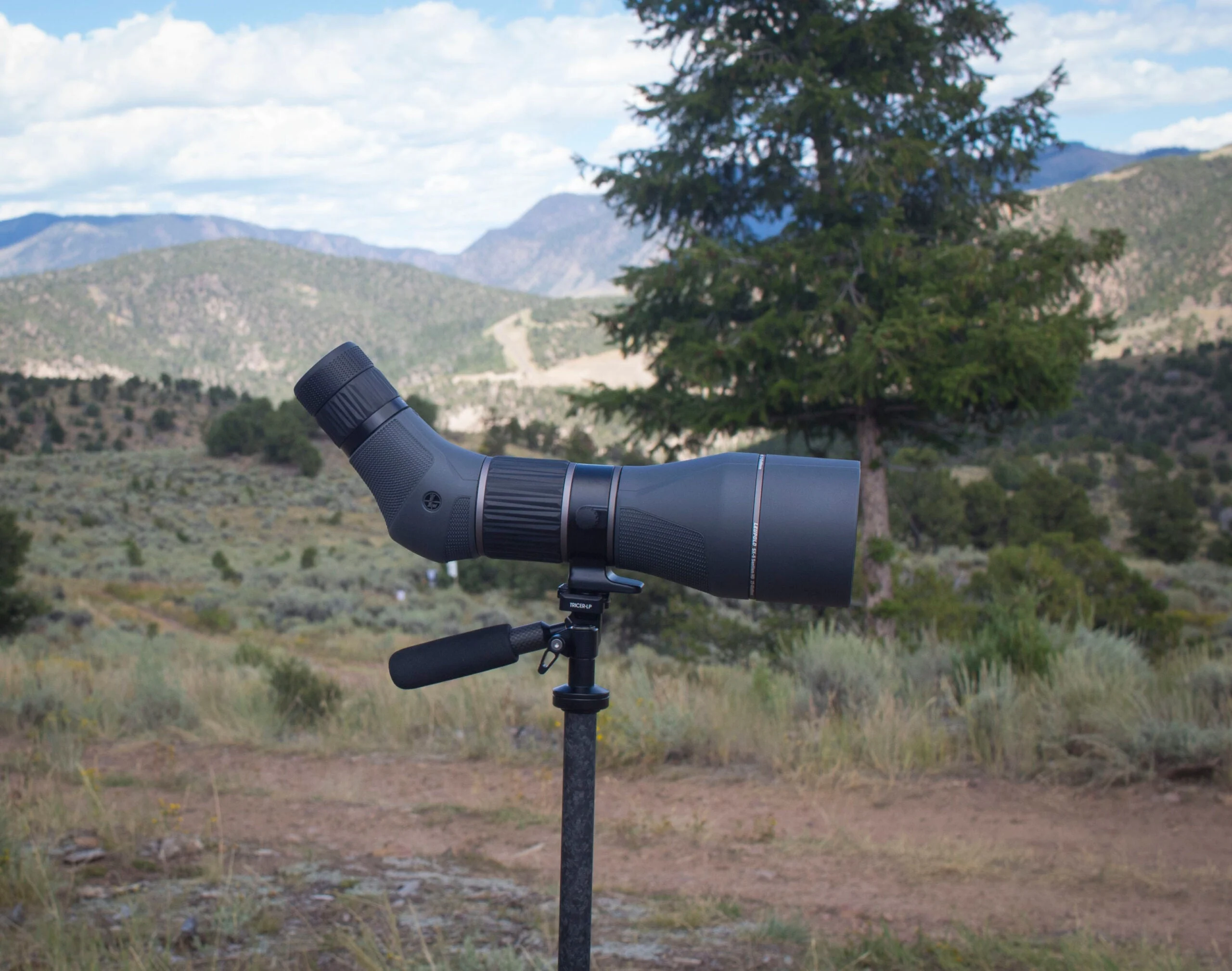
The same great optical resolution was still there in low-light conditions. We were able to make out almost all of the same groupings as we did in full light with zero blurring. Image quality still presented the same color shift, but that wasn’t surprising.
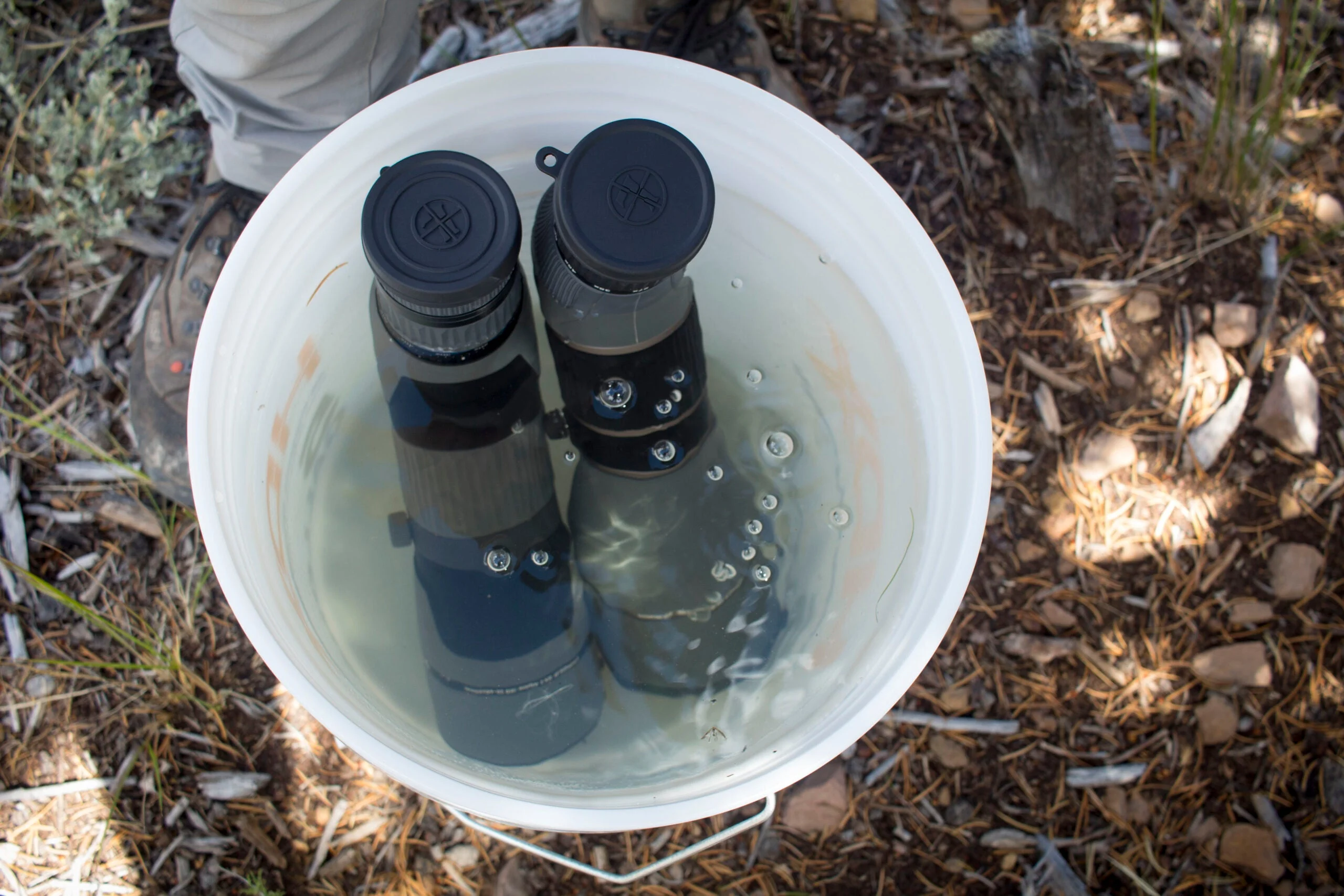
A lot of design features go into building a flagship scope, and Leupold nailed them all with the Santiam. It passed the weather testing with no issues. In addition, the build quality was superb. Smooth magnification and focus wheels made the scope incredibly easy to operate. Of all the scopes, it was the easiest to zoom and focus while staying on target. This also goes for the lens hood, which extends off the front with minimal resistance. The Santiam is on the heavier side compared to other premium scopes, but great optical resolution, low-light performance, and quality construction make it worthy of the flagship title. —MI
Maven CS.1A 15-45x65
Specs
Magnification: 15-45x
Objective Lens Diameter: 65mm
Weight: 40.4 ounces
Length: 11.4 inches
Eyepiece: Straight or angled
Total Score: 81
Pros
Good glass for an affordable price
Compact design
Great entry-level spotter
Strong magnification for compact scope
Quality optical resolution
Cons
Heavier for a compact spotter
The CS.1 offers middle-of-the-line quality glass and was the runner-up in our Best Compact category. It has a 15-45x magnification and weighs 40.4 ounces. We were impressed with the optical resolution from this Maven scope, which proved to match some of the full-size spotters. That quality also carried over in low-light performance, as one of the testers noted, “I’m surprised with how much we can see in the shade with this scope.”
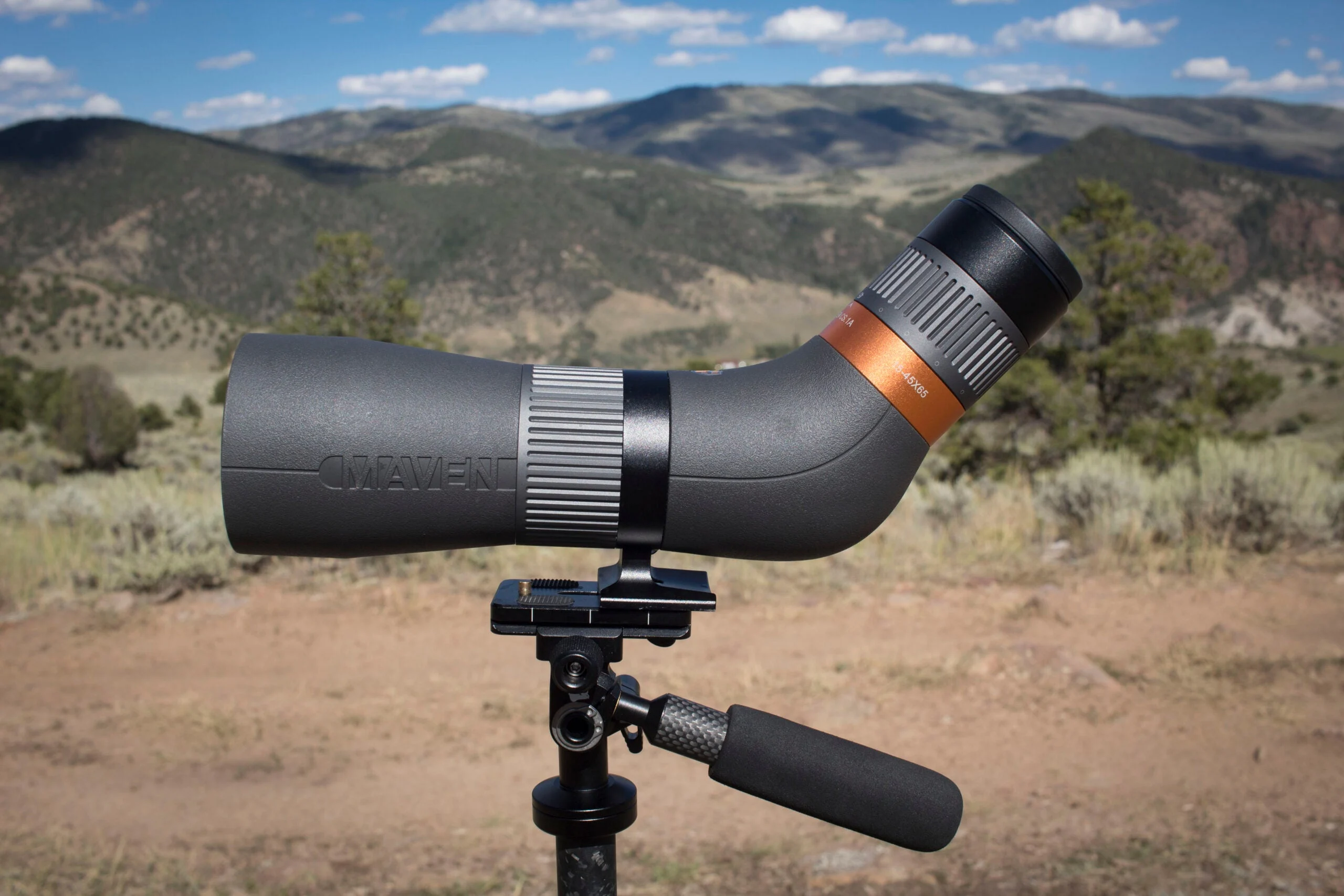
We recorded visual artifacts (image quality impairments) with some color shifting and stray light being observed when viewing the 1-inch black lines. The image also didn’t pop as much as other spotting scopes, and, at times, felt dark. That being said, the CS.1 costs $800, and for that price, it is well worth it.
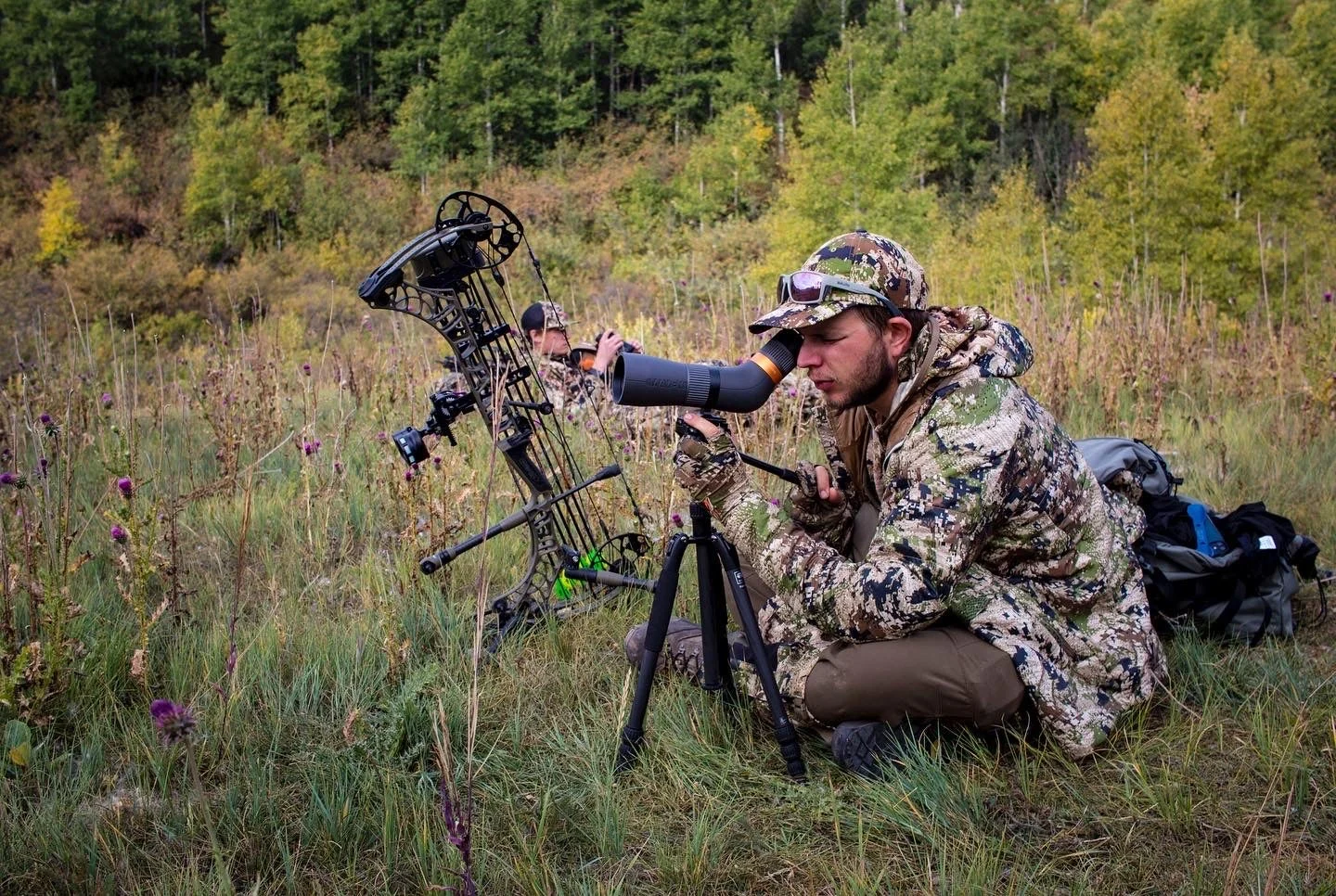
Maven markets this as a compact spotter, and its dimensions and weight back that up. While the CS.1 isn’t the lightest spotting scope available, it does a good job of minimizing pack weight and offering hunters visual detail at extended distances. It is 11.8 ounces heavier than the Vortex Razor, but the Maven CS.1 is $400 cheaper and has a stronger magnification. It’s a solid mid-range spotting and one we recommend for hunters looking for their first spotter. I carried the CS.1A in my hunting pack on multiple backcountry trips last season, and it answered the call every time. —RC
Tract Toric UHD 27-55×80
Specs
Magnification: 27-55x
Objective Lens Diameter: 80mm
Weight: 67 ounces
Length: 15.5 inches
Eyepiece: Angled only
Total Score: 81
Pros
Affordable
Reasonable weight
Great optic for the price
Cons
Some color shift
Stiffer zoom and focus
This test was our first chance to get hands-on experience with a Tract spotter. And we can now say with confidence that Tract makes quality products at a reasonable price. Our testing model was the full-size Toric UHD 27-55×80 spotting scope. It scored in the middle of the pack for optical resolution. Slight stray light and blurring were apparent when viewing objects. Low-light testing yielded similar results with the exception of slightly more blurring on object edges.

The Toric had no issues passing waterproof and fogproof tests. Scope ergonomics also faired well. The eyepiece was easy to operate and removable. A solid sun hood helped reduce stray light, but the zoom and focus wheels were noticeably stiffer than other scopes. That may loosen up over time, but in the span of our testing, we didn’t notice any changes. While optical quality may not be on par with premium scopes, it will do the job for most Western hunters. —MI
Meopta MeoPro HD 80 20–60×80
Specs
Magnification: 20-60X
Objective Lens Diameter: 80mm
Weight: 68 ounces w/ eyepiece
Length: 13.4 inches
Eyepiece: Straight or Angled
Total Score: 80
Pros
Fogproof and waterproof
Smooth zoom and focus knobs
Well-defined clicks at each tilt stop
Cons
No interchangeable eyepiece
The MeoPro HD 80 is Meopta’s version of an entry-level spotting scope. That said, its price point is higher than many consider “entry-level.” But the performance is comparable to other entry-level spotters we tested. The optical resolution was on par with the MeoStar S2, but that is where the similarities end. We saw noticeable stray light with distinct rainbow effects appearing on the edges of objects. We also ran into issues with a poor feeling of immersion, even at higher magnifications. Low-light performance was also unimpressive. Optical resolution didn’t vary much from standard light, but the poor feeling of immersion was amplified.

This scope does live up to its waterproof and fogproof claims, passing our testing with ease. However, we were not thrilled with the design. We did prefer the larger eyepiece over the MeoStar S2, but it isn’t removable. While not a deal breaker, for a scope of this price, we’d expect it to come with an interchangeable eyepiece. Zoom and focus knobs were crisp, as was the angle adjustment. The scope weight is reasonable at 68 ounces but doesn’t entirely fall into the lightweight category. Despite our gripes with the MeoPro HD, it performs well as an entry-level scope. Whether or not you think its price point is worth it is up to you. —MI
Cabela’s Intensity HD 20-60×80
Specs
Magnification: 20-60x
Objective Lens Diameter: 80mm
Weight: 69.8 ounces
Length: N/A
Eyepiece: Angled only
Total Score: 80
Pros
Very affordable
Fully waterproof/fogproof
Smooth focus wheel
Quality lens cap
Cons
Heavy
Stray light and color shifting recorded
Budget-level spotting scopes usually lack quality glass and good ergonomics, but still have their place for hunters who aren’t looking to spend thousands of dollars. The Cabela’s Intensity HD falls into that category. Its optical resolution was nothing to write home about, but it also wasn’t terrible either. We noticed some visual artifacts (stray light dots) and color shifting during the image quality test.
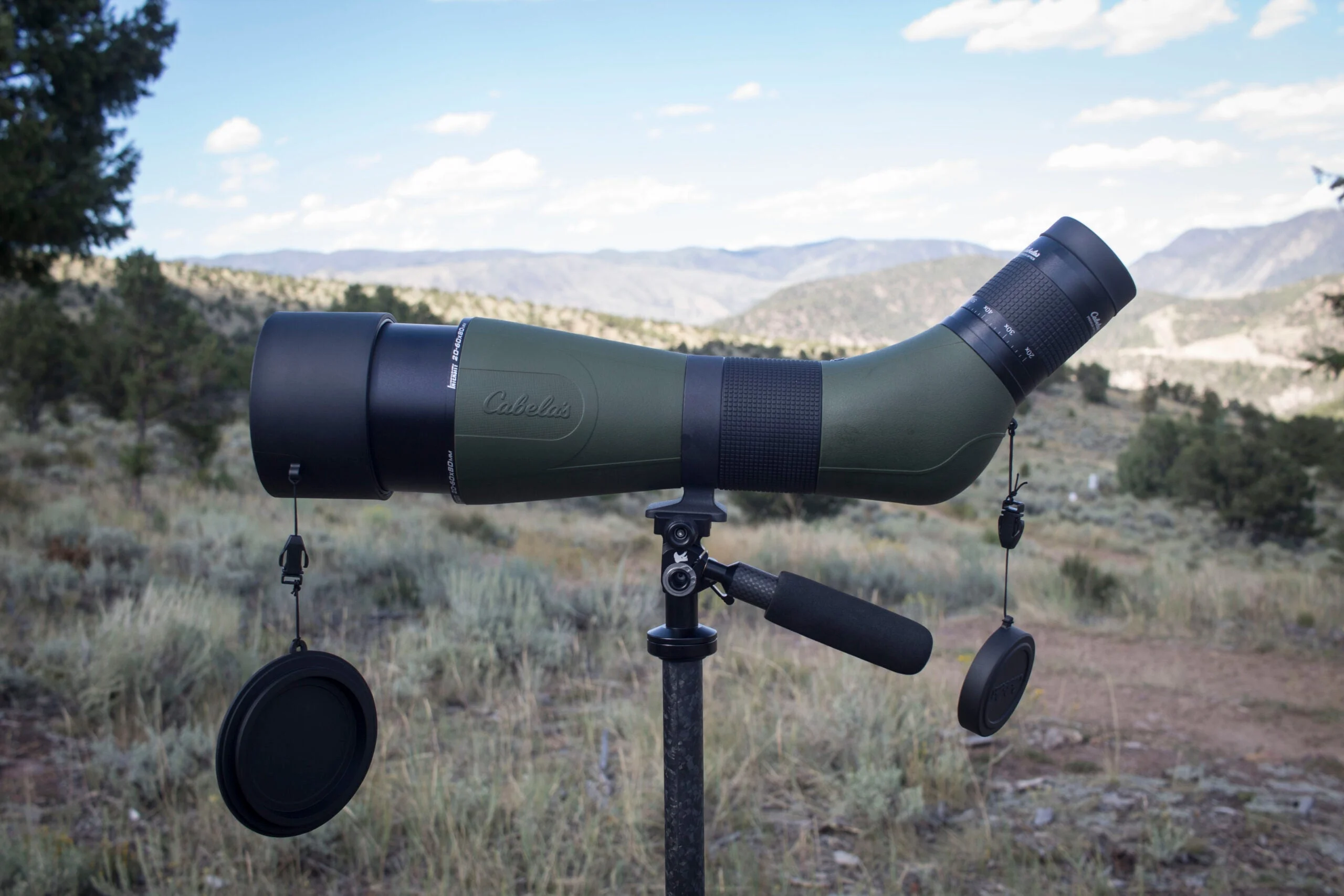
The Intensity HD performed just as well in dark shade as it did in full light. Meaning your optical resolution won’t get any worse when you spot an animal in fading light. This spotter impressed us in the weather resistance test—proving to be fully waterproof and fogproof. I also like that you can clip the lens cap onto the scope when in use, so you don’t have to worry about misplacing it. The dials were smooth and easy to fine-tune when focusing.
This was the heaviest scope we tested, and it was noticeable in the hand. But lightweight materials aren’t cheap, and the heavier weight of the Intensity HD matches the lower price tag. Hunters who aren’t too concerned about pack weight and not looking to burn a hole in their wallet should consider the Cabela’s Intensity HD. It would also serve as a good spotter to keep in the truck to glass from the road. —RC
Bushnell Engaged DX 20-60×80
Specs
Magnification: 20-60x
Objective Lens Diameter: 80mm
Weight: 60.3 ounces
Length: 15.4 inches
Eyepiece: Angled only
Total Score: 75
Pros
Affordable
Ideal for birdwatchers or as a range spotter
Fully waterproof/fogproof
Quality lens cap
Cons
Poor image quality
Visual artifacts recorded
The Bushnell Engaged DX performed surprisingly well in optical resolution, offering clear visuals on our benchmark grouping. But beyond that, this spotting scope doesn’t offer much for the dedicated hunter. We recorded visual artifacts—blurring around the edges and color shifting—which dramatically hurt the image quality. This also carried over into the low-light portion of the test.

But the Engaged DX fully passed the rugged weather resistance test and took home wins in small areas like quality lens caps and overall durability. This isn’t the spotter for hunters taking serious trips, but it still has a place at the range and for other activities like birding. I also wouldn’t hesitate to make this my stay-at-home spotter for watching wildlife off the back deck or carrying it in my truck to observe animals from the road. —RC
Bushnell Trophy Extreme 20-60×65
Specs
Magnification: 20-60x
Objective Lens Diameter: 65mm
Weight: 36.5 ounces
Length: 15 inches
Eyepiece: Straight only
Total Score: 72
Pros
Lightweight
Budget-friendly
Decent optical resolution
Cons
Stiff adjustments
Poor build quality
The Trophy Extreme was the cheapest spotter we tested. Unfortunately, its performance mirrored that of its price. Optical resolution was respectable, but after that, the scope began to fall off. Notable purple color shift appeared on objects regardless of magnification. Stray light was also apparent, as was blurring around the edges.
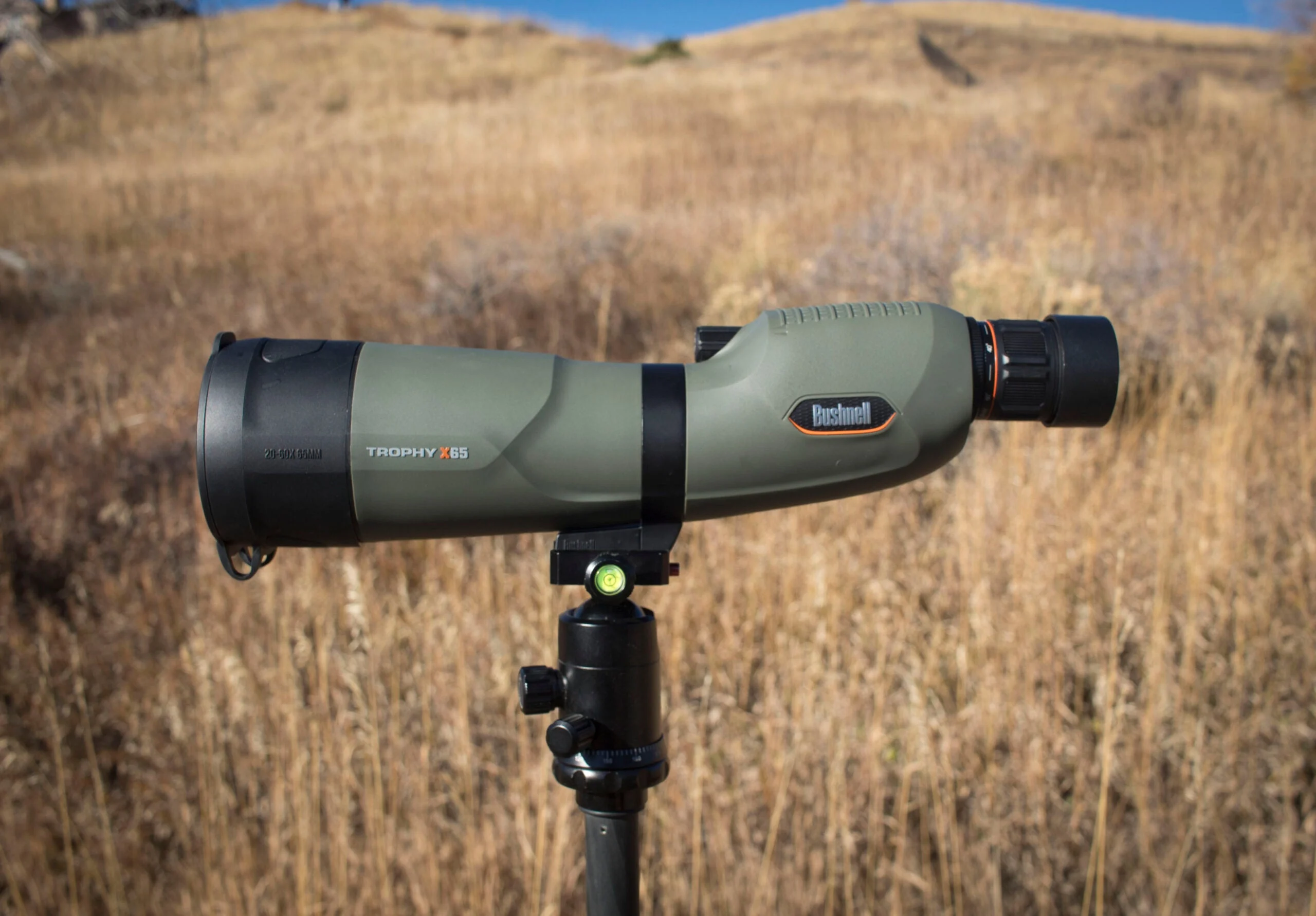
During low-light testing, the lack of quality became apparent. Optical resolution and image quality noticeably declined. Its design further lends it to a poor feeling of immersion. This scope is very budget-friendly, but you get what you pay for. It did pass our waterproof and fogproof test and, surprisingly, floated. If you’re looking for a reasonably priced scope, the Trophy Extreme will do the job. —MI
How We Tested Spotting Scopes
Our testing procedure consisted of six major categories: optical resolution, image quality, low-light performance, weather resistance, build quality/ergonomics, and value. We set up three poster boards, all at a distance of 100 yards. The first was a 1951 USAF Resolution Test Chart, which is the industry standard for judging optical resolution (detail resolved). We also set up a 1-inch thick black cross on a white background to record values corresponding to the chromatic aberration (color shifting) perceived.
Our testers judged image quality based on each spotter’s clarity, feeling of immersion, and visual artifacts, including stray light and field curvature (blurring at the edges). To keep low light conditions as consistent as possible, we placed another USAF Resolution Test Chart in deep shade at a distance of 100 yards. We found this to be the most reliable and fair way of judging low-light performance. Gathering consistent results at dusk is almost impossible due to fading light, so we made sure each scope viewed the test chart in the same amount of darkness.
We developed a weather resistance test that we felt no scope should pass. Our thought process was that if a scope could handle this, it could handle any conditions a hunter might face in the field. So we submerged each scope in a 5-gallon bucket of water and then froze them for 30 minutes. We looked for fogging, waterproof ability, and clarity. We recorded any negative effects.
Lastly, we judged the overall feel of each scope in the hand, as well as the quality and functionality of the focus wheel, eyepieces, lens caps, and any other accessories. We also considered the value of each scope, factoring in the quality, overall performance, and price.

How We Scored the Spotting Scopes
We scored each spotting scope for the following categories using the procedure above. We then added up the six categories and multiplied the score by two to get a final score out of 100.
Optical Resolution (10 points)
Image Quality (10 points)
Low-light performance (10 points)
Weather resistance (10 points)
Build Quality/Ergonomics (5 points)
Value (5 points)

What To Look for in a Spotting Scope
We designed the test so that our scoring categories are many of the considerations hunters should think about before purchasing a spotting scope. But there are some fancy terms like “visual artifacts” and “color aberration” that may be confusing. Below is a breakdown of each category we scored, with some more explanation of what hunters should consider in a new spotting scope and why.
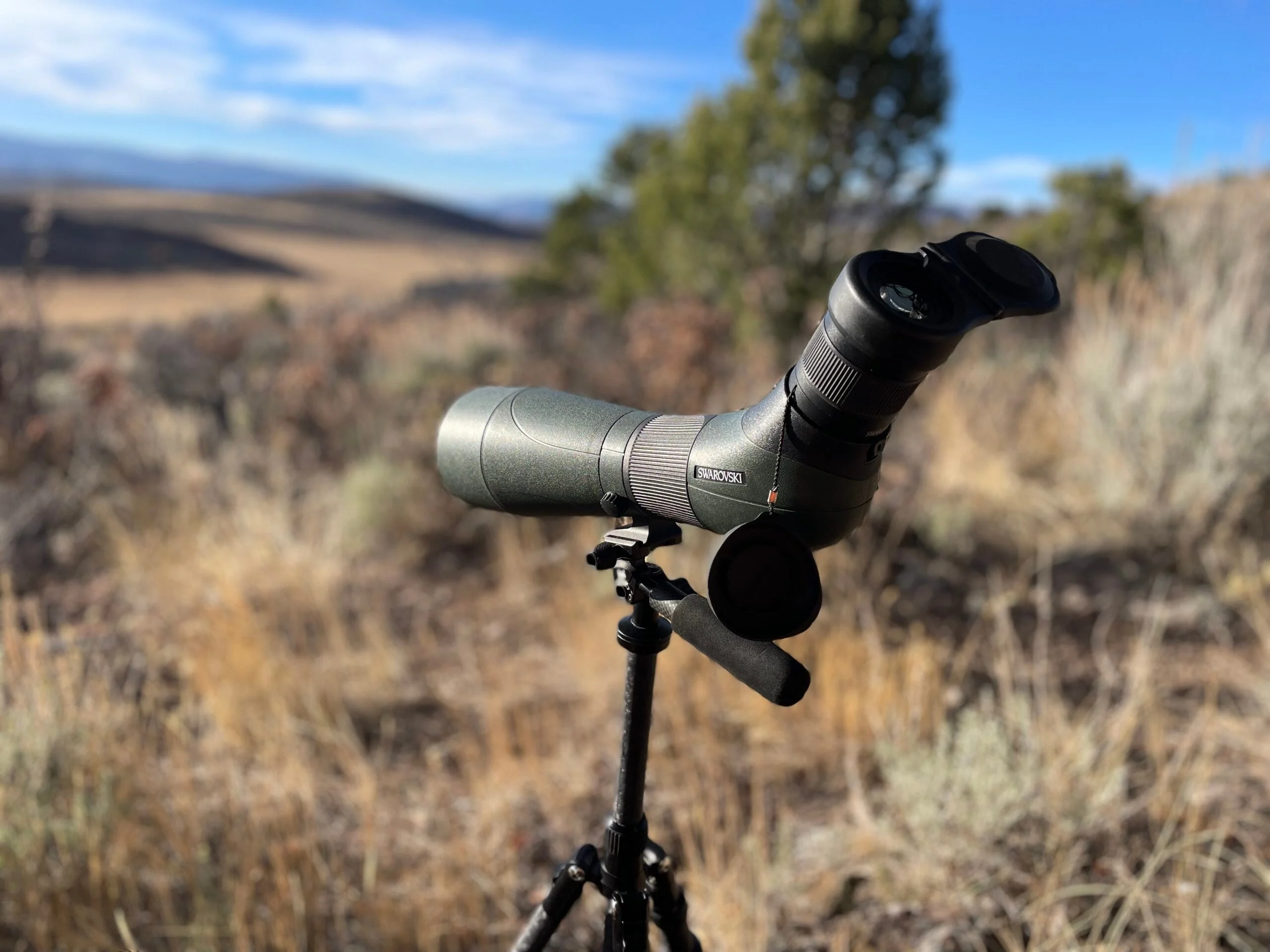
Pursuit
What do you need a spotting scope for? Are you going deep into the backcountry? Or are you looking for something to carry in the truck? These questions will help point you in the right direction. Backcountry hunters might want to save every ounce possible and opt for the most compact spotter they can get. But if you need strong magnification for glassing animals at long distances, you’d want a full-size spotter and a wide objective lens. Figure out what you need in a spotting scope first, then tailor your search for those specific features.
Optical Resolution
The simple definition of optical resolution when referring to spotting scopes is the ability of the spotter to resolve detail in what is being viewed. In other words, better glass is going to be able to make out more detail than low-quality glass. For instance, a hunter might be able to see every tine on a mule deer at 400 yards with good optical resolution, whereas they can only make out the frame of the antlers with poor optical resolution.
Image Quality
Obviously, you want your spotter to be as clear as possible. When judging the spotting scopes in this test, we looked for color aberration, a.k.a. color shifting. This can appear as a rainbow streak across the lens, which degrades image quality. You also don’t want any stray light—whether streaks or dots—across the lens. These things are impossible to know without testing the optic, so read the reviews above for careful consideration.
Low-light Performance
Some of the best hunting happens at dawn and dusk when there is limited light. The more you can see in your spotter at these times, the better. Make sure to read reviews about low-light performance before shelling out your money.
Durability
An excellent spotter is fully waterproof and fogproof. Most of the spotting scopes above passed our abusive weather resistance test, but some didn’t. Your optic should be able to withstand harsh conditions, including a durable frame that can take a few bumps and bruises.
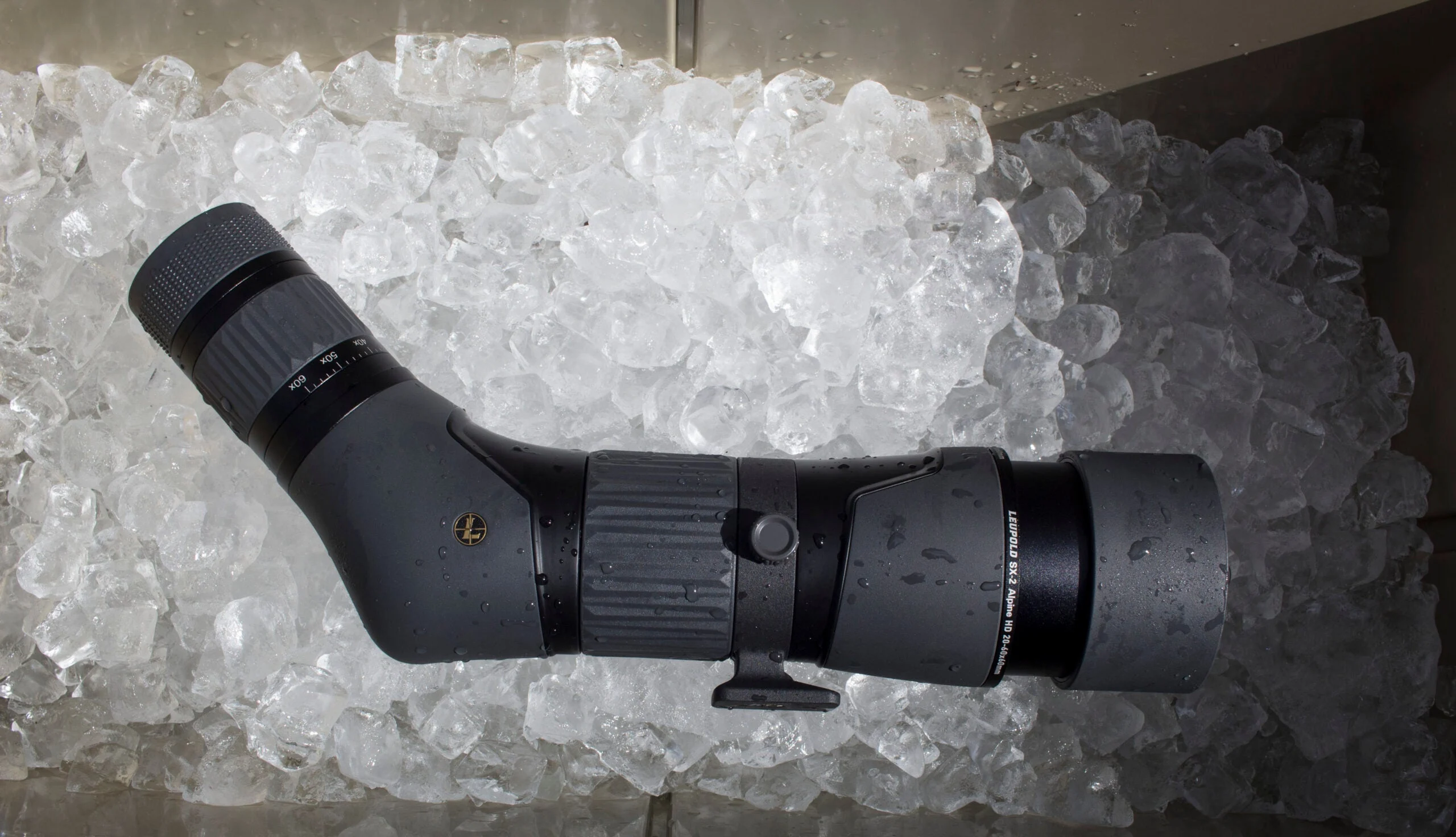
Budget
Usually, the better the glass you opt for, the higher the price tag will be. But that doesn’t mean every hunter needs to spend thousands for a great spotting scope. There are plenty of budget options as well as value picks that offer quality features. If you’re looking for the best of the best, the Swaro and Leica are your choices. But most hunters will find excellent glass, build, and image clarity in the Sig Sauer Oscar 8, Meopta Meostar, Maven S1, and Nikon Monarch.
Tripods
For this test, we used the Tricer AD tripod and the Vortex High Country II Aluminum Tripod. Both are great tripods, but the Tricer AD stood out as the best (it’s what we’ve taken into the field on all our hunts this year). What makes it so great is the inverted leg design, which features the bigger legs at the bottom for increased stability. This is most noticeable when the tripod is fully extended. We could see the difference in stability between the two tripods during the test. Oh, and it’s the lightest tripod we’ve ever tested (33 ounces)—perfect for backcountry hunts.
When folded down in the standard position, it collapses to 23 inches. When fully extended, it can support up to 26 pounds of weight. It is a do-it-all tripod with superb strength and versatility. Hunters can also buy a pan head, a bino adapter, and an arca plate from the Tricer website.
Digiscoping
No longer are the days of having to buy a specific digiscoping adapter for each model of spotting scope. MagView changed the game with their innovative, universal phone adapter that works with the majority of spotters on the market. We received two units from MagView for this test, which fit every spotter except the Meopta scopes.
The S1 adapter includes one stainless steel phone plate that adheres to the back of a phone and securely attaches to the adapter (via a strong magnet) on the spotting scope. The best part is that the S1 comes with multiple rings that allow it to fit on eyepiece sizes 51-60mm. This allowed us to capture incredible images of game throughout the test. It is the best digiscoping adapter on the market and a must-have for any serious big game hunter who spends time behind the glass.
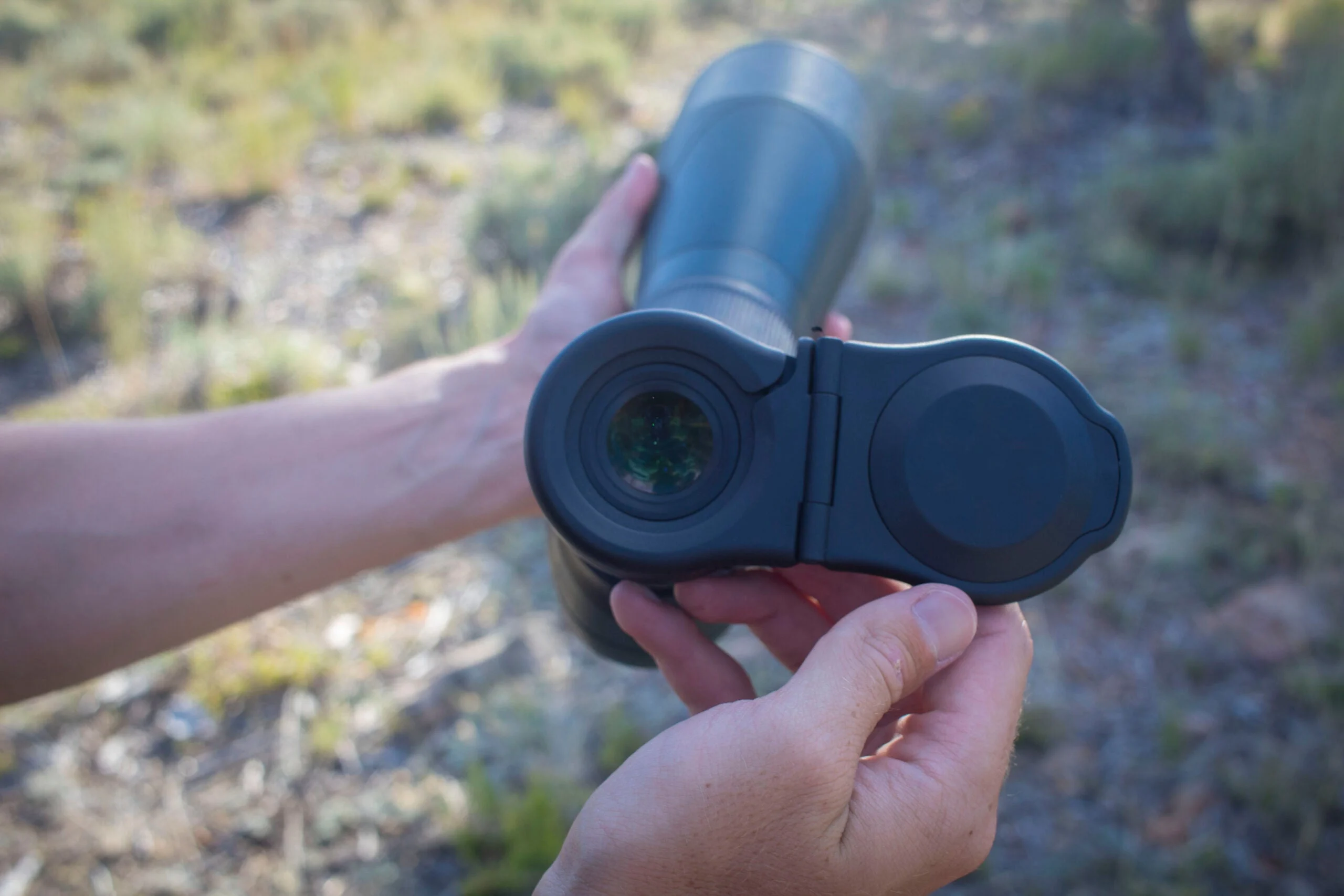
FAQs
Q: What is a good tripod for a spotting scope?
We recommend using the Tricer AD tripod for your spotting scope. The inverted leg design creates a stable structure to glass from. It is also incredibly lightweight and durable for backcountry adventures.
Q: Which is better: straight or angled spotting scope?
The choice between an angled or straight eyepiece is one of personal preference. Our testers prefer angler spotters (hence most test scopes being angled) because we feel they’re more comfortable and easy to view through in both standing and sitting positions. Angled is also better for digiscoping.
Q: What is the minimum distance for a spotting scope?
A quality spotting scope can resolve detail on animals and objects over 1,000 yards away. But the closer the object, the better you’ll be able to see it. We judged all of the spotters at 100 yards for optical resolution and image quality. Most hunters use spotting scopes to help find and identify animals at distances of 200 yards and out.
Final Thoughts
Hunters aren’t looking for the newest spotting scope, but rather the best. And that’s what the Swarovski ATS 80 is—the best spotting scope on the market. We also found other great optics that proved their worth at various price points. So, decide what you’re willing to pay and what you need out of a spotter, then choose one from this list that best fits your needs. You won’t be disappointed.
Why Trust Us
For more than 125 years, Field & Stream has been providing readers with honest and authentic coverage of outdoor gear. Our writers and editors eat, sleep, and breathe the outdoors, and that passion comes through in our product reviews. You can count on F&S to keep you up to date on the best new gear. And when we write about a product—whether it’s a bass lure or a backpack—we cover the good and the bad, so you know exactly what to expect before you decide to make a purchase.

